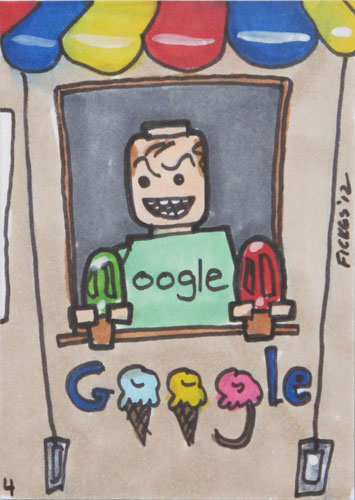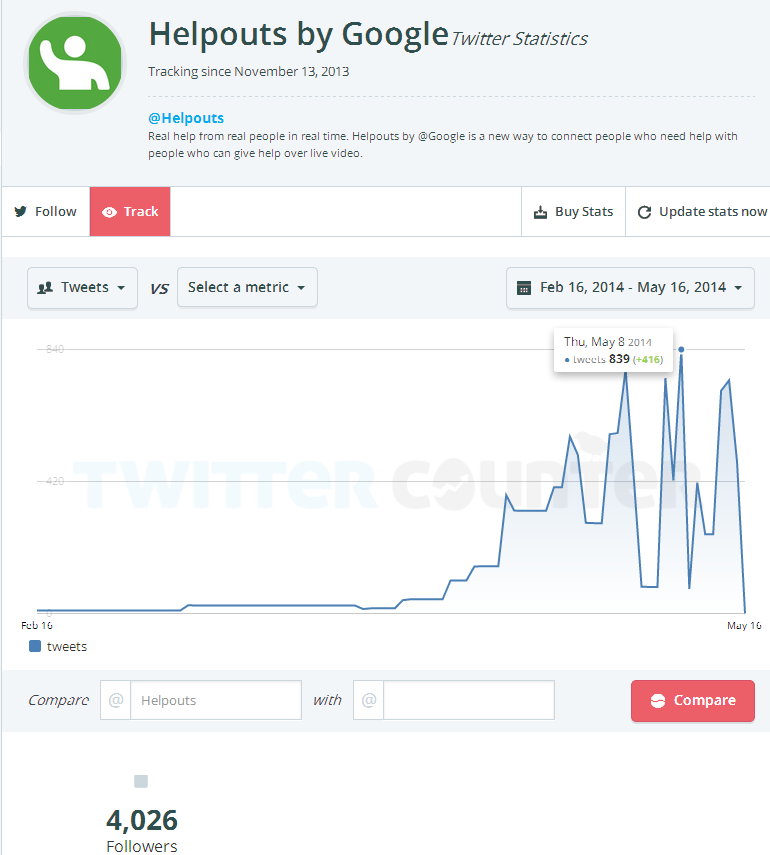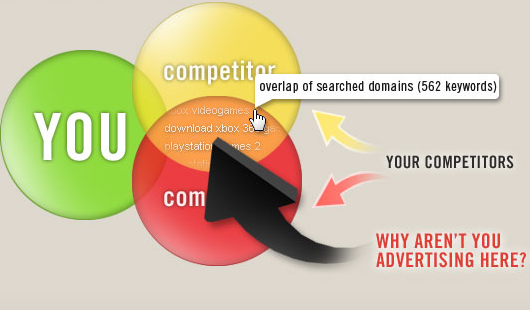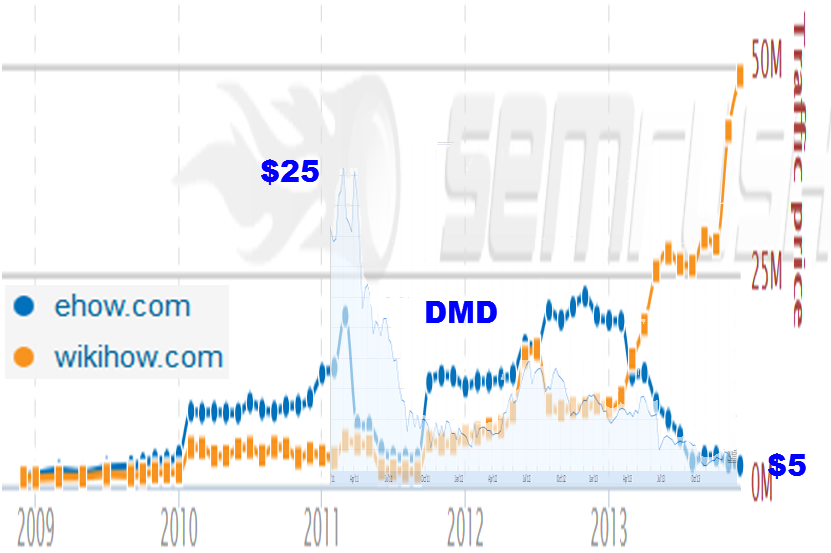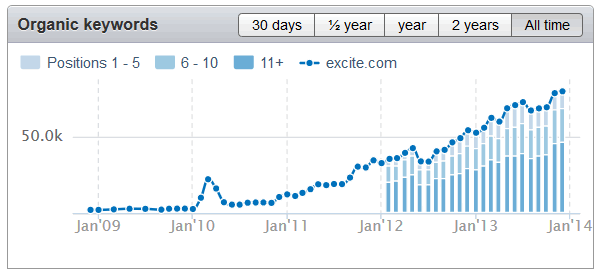Building a Legal Moat for Your SEO Castle

About a month ago a year old case of an SEO firm being sued by it’s client resurfaced via a tweet from Matt Cutts.
I’d like to add something to this conversation that will be helpful for you as a service provider seeking to avoid that really, really scary issue.
Some quick background information if I may? No specifics are allowed but I’ve been a party, on both sides, to actual litigation pertaining to SEO contracts (not services rendered, just contractual issues with a third-party).
I’ve been the plaintiff and the defendant in cases involving contractual disputes and legal obligations so I, much to my dismay, speak from experience.
Suffice to say I’m not a lawyer, don’t act on any of this advice without talking it over with your counsel so they can tailor it to your specific needs and state law.
Basic Protections
There are essentially 3 ways to legally protect yourself and/or your company objectively. I say objectively because anyone can sue you for anything and “service” is a subjective term as are “results” unless they are specifically spelled out in your contract.
Objectively speaking, the law gives you 3 broad arenas for protective measures:
- Contracts
- Entity Selection
- Insurance
Contracts
Get a real lawyer, do not use internet “templates” and do not modify any piece of the contract yourself. Make sure your attorney completely understands what you do. A good lawyer will listen to you. Heck, mine now knows who Matt Cutts is and where the Webmaster Guidelines are located and what “anchor text” is :)
Your contracts need to cover the following scenarios:
- Client services
- Vendor relationships
- Employee/Contractor relationships
For standard client agreements you’ll want to cover some basic areas:
- Names of the legal entities partaking in the agreement
- Duties and nature of services
- Term and termination (who can cancel and when, what are the ramifications, etc)
- Fees
- No exclusive duty (a clause that says you can work with other clients and such)
- Disclaimer, Limitation of Liability
- Confidentiality
- Notices (what is considered legal notice? a letter? certified mail? email?)
- Governing law
- Attorney’s fees (if you need to enforce the contract make sure you can also collect fees)
- Relationship of Parties (spell out the relationship; independent entities? partners? joint ventures? spell out exactly what you are and what you are not
- Scope of Work
- Signatures (you should sign as you are in your entity; member, president, CEO, etc)
Some important notes are needed to discussion a couple of core areas of the contract:
For Governing law go with your home state if possible. Ideally, I try to get an arbitration clause in there rather than state law so in case there is a dispute it goes to a much less expensive form of resolution.
However, you can make an argument that if your contract is signed with your home state as governing law and your language is strong you are better off doing that instead of arbitration where one person makes a decision and no appeal is available.
For Limit of Liability go broad, real broad. You want to spell out that organic search (or just about any service) is not guaranteed to produce results, no promises were made, Google does not fully publish the algorithim thus you can’t be held liable for XYZ that happens.
Also, if your client is asking you to do things against webmaster guidelines, and you decide to do them, you NEED to get that documented. Have them email it to you, record the call, something. Here is the liability clause in my contract:
Client agrees and acknowledges that the internet is an organic, constantly shifting entity, and that Client’s ranking and/or performance in a search engine may change for many reasons and be affected by many factors, including but not limited to any actual or alleged non-compliance by Provider to guidelines set forth by Google related to search engine optimization.
Client agrees that no representation, express or implied, and no warranty or guaranty is provided by Provider with respect to the services to be provided by Provider under this Agreement. Provider’s services may be in the form of rendering consultation which Client may or may not choose to act on. To the maximum extent permitted by law, Client agrees to limit the liability of Provider and its officers, owners, agents, and employees to the sum of Provider’s fees actually received from Client.
This limitation will apply regardless of the cause of action or legal theory pled or asserted. In no event shall Provider be liable for any special, incidental, indirect, or consequential damages arising from or related to this Agreement or the Project. Client agrees, as a material inducement for Provider to enter into this Agreement that the success and/or profitability of Client’s business depends on a variety of factors and conditions beyond the control of Provider and the scope of this Agreement. Provider makes no representations or warranties of any kind regarding the success and/or profitability of Client’s business, or lack thereof, and Provider will not be liable in any manner respecting the same.
Client agrees to indemnify and hold harmless Provider and its officers, owners, agents, and employees from and against any damages, claims, awards, and reasonable legal fees and costs arising from or related to any services provided by Provider, excepting only those directly arising from Provider’s gross negligence or willful misconduct.
For vendor and independent contractor agreements you’ll want most of the aforementioned clauses (especially the relationship of parties) in addition to a few more things (for employee stuff, get with your lawyer because states are quite different and a lot of us use remote workers in different states)
- Non-Competition and non-interference
- Non-Solicitation and non-contact
These clauses essentially prohibit the pursuit of your clientele and employees by a vendor/contractor for a specified period of time.
Legal Entity
Don’t be a sole proprietor, ever. If you’re a smaller shop you might consider being a single member LLC (just you), an LLC (you and employees), or an S Corp. If you’re a larger operation you might want to incorporate and go Inc.
The benefits of the LLC set up are:
- Your personal assets are generally untouchable (providing you are not co-mingling funds in a bank account)
- Very easy to administer compared to other options
- Your liability is limited to company assets (pro tip: clear out your business bank account each month minus some operating margin, move it to personal savings)
Benefits of an S Corp are:
- Same protections as LLC
- You save a fair amount on self employment taxes (more below)
With the S Corp there’s more paperwork and filings but if you are earning a fair bit of money it may be worth it to you. Here’s a good article breaking this all down, and a excerpt:
“If you operate your business as a sole proprietorship or partnership/LLC, you will pay roughly 15.3% in self-employment taxes on your $100,000 of profits. The calculations get a little tricky if you want to be really super-precise but you can think about self-employment tax as roughly a 15% tax. So 15% on $100,000 equals $15,000. Roughly.”
“With an S corporation, you split your business profits into two categories: “shareholder wages” and “distributive share.” Only the “shareholder wages” get subjected to the 15.3% tax. The leftover “distributive share” is not subject to 15.3% tax.”
Be careful here (and I’m not a CPA so don’t do anything without consulting with your accountant) not to be absurd with your wages. So, if your net income is 1 million don’t take 25k in wages and 975k as a distribution.
Some final thoughts on entities:
- Most of you will probably fall into the LLC/S S Corp category, get with your attorney and accountant
- Keep everything separate because if you don’t (credit cards, bank accounts, etc) your personal assets might be at risk due to the “piercing of the corporate veil”
Insurance
As you would imagine, insurance policies are few and far between for our industry. You can get general liability for your office, workers comp for your employees, disability for yourself, and so on. However, what you might want to look into is a professional liability policy.
You’ll probably end up looking at a miscellaneous one like the one here (marketing consultant?) offered by Travelers. You’ll probably have to educate your agent on your business practices to ensure proper coverage.
This might be worth it just due to the legal protection clause; meaning they will pay for a lawyer to defend you. Having the proper entity classification might protect your assets but paying lawyers is expensive to defend even frivolous lawsuits.
Record Keeping
This is a bit out of the “contract” topic but good record keeping is essential. If you use a project management and/or a CRM system you really should make sure you can export when you need it.
Many online CRM applications and project management applications have limited export capabilities especially when it comes to export comments and notes on things like tasks and records. Most have an API that you can have a developer custom code to export your stuff. I’d look into this as well.
Final Thoughts
Get with your attorney and CPA to get your specific situations up to legal snuff if you haven’t already. Don’t act on my advice as I’m not a lawyer nor a CPA. Contracts and agreements are not fun to negotiate and can be even harder when you work with people you generally trust.
However, when it comes to business dealings and contracts I would save my trust for my lawyer :)
Have We Reached Peak Advertising?
The internet runs on advertising. Google is funded almost entirely by advertising. Facebook , likewise. Digital marketing spends continue to rise:
Internet advertising revenues in the United States totaled $12.1 billion in the fourth quarter of 2013, an increase of 14% from the 2013 third-quarter total of $10.6 billion and an increase of 17% from the 2012 fourth-quarter total of $10.3 billion. 2013 full year internet advertising revenues totaled $42.78 billion, up 17% from the $36.57 billion reported in 2012.
Search advertising spend comes out on top, but that’s starting to change:
Search accounted for 41% of Q4 2013 revenues, down from 44% in Q4 2012, as mobile devices have shifted. Search-related revenues away from the desktop computer. Search revenues totaled $5.0 billion in Q4 2013, up 10% from Q4 2012, when Search totaled $4.6 billion
The growth area for digital advertising lays in mobile:
Mobile revenues totaled 19% of Q4 2013 revenues, or $2.3 billion, up 92% from the $1.2 billion (11% of total) reported in Q4 2012
Prominent venture capitalist, Mary Meeker, recently produced an analysis that also highlights this trend.
So, internet advertising is growing, but web internet adoption is slowing down. Meanwhile, mobile and tablet adoption is increasing fast, yet advertising spend on these mediums is comparatively low. Nice opportunity for mobile, however mobile advertising is proving hard to crack. Not many people are clicking on paid links on mobile. And many mobile ad clicks are accidental, driving down advertiser bids.
This is not just a problem for mobile. There may be a problem with advertising in general. It’s about trust, and lack thereof. This situation also presents a great opportunity for selling SEO.
But first, a little background….
People Know More
Advertising’s golden age was in the 50’s and 60’s.
Most consumers were information poor. At least, they were information poor when it came to getting timely information. This information asymmetry played into the hands of the advertising industry. The advertising agency provided the information that helped match the problems people had with a solution. Of course, they were framing the problem in a way that benefited the advertiser. If there wasn’t a problem, they made one up.
Today, the internet puts real time information about everything in the hands of the consumer. It is easy for people to compare offers, so the basis for advertising – which is essentially biased information provision – is being eroded. Most people see advertising as an intrusion. Just because an advertiser can get in front of a consumer at “the right time” does not necessarily mean people will buy what the advertiser has to offer with great frequency.
Your mobile phone pings. “You’re passing Gordon’s Steak House….come in and enjoy our Mega Feast!” You can compare that offer against a wide range of offers, and they can do so in real time. More than likely, you’ll just resent the intrusion. After all, you may be a happy regular at Susan’s Sushi.
“Knowing things” is not exclusive. Being able to “know things” is a click away. If information is freely available, then people are less likely to opt for whatever is pushed at them by advertisers at that moment. If it’s easy to research, people will do so.
This raises a problem when it comes to the economics of content creation. If advertising becomes less effective for the advertiser, then the advertisers is going to reduce spend, or shift spend elsewhere. If they do, then what becomes of the predominant web content model which is based on advertising?
Free Content Driven By Ads May Be An Unsustainable Model
We’re seeing it in broadcast television, and we’ll see it on the web.
Television is dying and being replaced by the Netflix model. There is a lot of content. There are not enough advertisers paying top dollar as the audience is now highly fragmented. As a result, a lot of broadcast television advertising can be ineffective. However, as we’ve seen with Netflix and Spotify, people are prepared to pay directly for the content they consume in the form of a monthly fee.
The long term trend for advertising engagement on the web is not favourable.
The very first banner advertisement appeared in 1994. The clickthru rate of that banner ad was a staggering 44% It had a novelty value, certainly. The first banner ad also existed in an environment where there wasn’t much information. The web was almost entirely about navigation.
Today, there is no shortage of content. The average Facebook advertisement clickthrough rate is around 0.04%. Advertisers get rather excited if they manage to squeeze 2% or 3% click-thrus rates out of Facebook ads.
Digital advertising is no longer novel, so the click-thru rate has plummeted. Not only do people feel that the advertising isn’t relevant to them, they have learned to ignore advertising even if the ad is talking directly to their needs. 97-98% of the time, people will not click on the ad.
And why should they? Information isn’t hard to come by. So what is the advertiser providing the prospective customer?
Even brand engagement is plummeting on Facebook as the novelty wears off, and Facebook changes policy:
According to a new report from Simply Measured, the total engagement for the top 10 most-followed brands on Facebook has declined 40 percent year-over-year—even as brands have increased the amount of content they’re posting by 20.1 percent.
Is Advertising Already Failing?
Our industry runs on advertising. Much of web publishing runs on advertising.
However, Eric Clemons makes the point that the traditional method of advertising was always bound to fail, mainly because after the novelty wears off, it’s all about interruption, and nobody likes to be interrupted.
But wait! Isn’t the advantage of search that it isn’t interruption advertising? In search, the user requests something. Clemons feels that search results can still be a form of misdirection:
Misdirection, or sending customers to web locations other than the ones for which they are searching. This is Google’s business model. Monetization of misdirection frequently takes the form of charging companies for keywords and threatening to divert their customers to a competitor if they fail to pay adequately for keywords that the customer is likely to use in searches for the companies’ products; that is, misdirection works best when it is threatened rather than actually imposed, and when companies actually do pay the fees demanded for their keywords. Misdirection most frequently takes the form of diverting customers to companies that they do not wish to find, simply because the customer’s preferred company underbid.
He who pays becomes “relevant”:
it is not scalable; it is not possible for every website to earn its revenue from sponsored search and ultimately at least some of them will need to find an alternative revenue model.
The companies that appear high on PPC are the companies who pay. Not every company can be on top, because not every company can pay top dollar. So, what the user sees is not necessarily what the user wants, but the company that has paid the most – along with their quality score – to be there.
But nowadays, the metrics of this channel have changed dramatically, making it impossible or nearly impossible for small and mid-sized business to turn a profit using AdWords. In fact, most small businesses can’t break even using AdWords.This goes for many large businesses as well, but they don’t care. And that is the key difference, and precisely why small brands using AdWords nowadays are being bludgeoned out of existence
Similarly, the organic search results are often dominated by large companies and entities. This is a direct or side-effect of the algorithms. Big entities create a favourable footprint of awareness, engagement and links as a result of PR, existing momentum, brand recognition, and advertising campaigns. It’s a lot harder for small companies to dominate lucrative competitive niches as they can’t create those same footprints.

Certainly when it comes to PPC, the search visitor may be presented with various big player links at the expense of smaller players. Google, like every other advertising driven medium, is beholden to it’s big advertisers. Jacob Nielsen noted in 1998:
Ultimately, those who pay for something control it. Currently, most websites that don’t sell things are funded by advertising. Thus, they will be controlled by advertisers and will become less and less useful to the users”
If Interruption Advertising Is Failing, Is Advertising Scalable?
Being informed has changed customer behaviour.
The problem is not the medium, the problem is the message, and the fact that it is not trusted, not wanted, and not needed.
People don’t trust ads. There is a vast literature to support this. Is it all wrong?
People don’t want ads. Again, there is a vast literature to support this. Think about your own behavior, you own channel surfing and fast forwarding and the timing of when you leave the TV to get a snack. Is it during the content or the commercials?
People don’t need ads. There is a vast amount of trusted content on the net. Again, there is literature on this. But think about how you form your opinion of a product, from online ads or online reviews?
There is no shortage of places to put ads. Competition among them will be brutal. Prices will be driven lower and lower, for everyone but Google.
If the advertising is not scaleable, then a lot of content based on advertising will die. Advertising may not be able to support the net:
Now reality is reasserting itself once more, with familiar results. The number of companies that can be sustained by revenues from internet advertising turns out to be much smaller than many people thought, and Silicon Valley seems to be entering another “nuclear winter”
A lot of Adsense publishers are being kicked from the program. Many are terminated, without reason. Google appear to be systematically culling the publisher herd. Why? Shouldn’t web publishing, supported by advertising, be growing?
The continuing plunge in AdSense is in sharp contrast to robust 20% revenue growth in 2012, which outpaced AdWords’ growth of 19%…..There are serious issues with online advertising affecting the entire industry. Google has reported declining value from clicks on its ads. And the shift to mobile ads is accelerating the decline, because it produces a fraction of the revenue of desktop ads.
Matt Sanchez, CEO of San Francisco based ad network Say Media, recently warnedthat, “Mobile Is Killing Media.”
Digital publishing is headed off a cliff … There’s a five fold gap between mobile revenue and desktop revenue… What makes that gap even starker is how quickly it’s happening… On the industry’s current course, that’s a recipe for disaster.
Prices tumble when consumers have near-perfect real time information. Travel. Consumer goods. Anything generic that can be readily compared is experiencing falling prices and shrinking margins. Sales growth in many consumer categories is coming from the premium offerings. For example, beer consumption is falling across the board except in one area: boutique, specialist brews. That market sector is growing as customers become a lot more aware of options that are not just good enough, but great. Boutique breweries offer a more personal relationship, and they offer something the customer perceives as being great, not just “good enough”.
Mass marketing is expensive. Most of the money spent on it is wasted. Products and services that are “just good enough” will be beaten by products and services that are a precise fit for consumers needs. Good enough is no longer good enough, products and services need to be great and precisely targeted unless you’ve got advertising money to burn.
How Do We Get To These Consumers If They No Longer Trust Paid Advertising?
Consumers will go to information suppliers they trust. There is always demand for a trusted source.
Trip Advisor is a great travel sales channel. It’s a high trust layer over a commodity product. People don’t trust Trip Advisor, per se, they trust the process. Customers talk to each other about the merits, or otherwise, of holiday destinations. It’s transparent. It’s not interruption, misleading or distracting. Consumers seek it out.
Trust models will be one way around the advertising problem. This suits SEOs. If you provide trusted information, especially in a transparent, high-trust form, like Trip Advisor, you will likely win out over those using more direct sales methods. Consumers are getting a lot better at tuning those out.
The trick is to remove the negative experience of advertising by not appearing to be advertising at all. Long term, it’s about developing relationships built on trust, not on interruption and misdirection. It’s a good idea to think about advertising as a relationship process, as opposed to the direct marketing model on which the web is built – which is all about capturing the customer just before point of sale.
Rand Fishkin explained the web purchase process well in this presentation. The process whereby someone becomes a customer, particularly on the web, isn’t all about the late stages of the transaction. We have to think of it in terms of a slow burning relationship developed over time. The consumer comes to us at the end of an information comparison process. Really, it’s an exercise in establishing consumer trust.
Amazon doesn’t rely on advertising. Amazon is a trusted destination. If someone wants to buy something, they often just go direct to Amazon. Amazon’s strategy involves what it calls “the flywheel”, whereby the more things people buy from Amazon, the more they’ll buy from Amazon in future. Amazon builds up a relationship rather than relying on a lot of advertising. Amazon cuts out the middle man and sells direct to customers.
Going viral with content, like Buzzfeed, may be one answer, but it’s likely temporary. It, too, suffers from a trust problem and the novelty will wear off:
Saying “I’m going to make this ad go viral” ignores the fact that the vast majority of viral content is ridiculously stupid. The second strategy, then, is the high-volume approach, same as it ever was. When communications systems wither, more and more of what’s left is the advertising dust. Junk mail at your house, in your email; crappy banner ads on MySpace. Platforms make advertising cheaper and cheaper in a scramble to make up revenue through volume.
It’s not just about supplying content. It could be said newspapers are suffering because bundled news is just another form of interruption and misdirection, mainly because it isn’t specifically targeted:
Following The New York Times on Twitter is just like paging through a print newspaper. Each tweet is about something completely unrelated to the tweets before it. And this is the opposite of why people usually follow people and brands online. It’s not surprising that The New York Times have a huge problem with engagement. They have nothing that people can connect and engage with
Eventually, the social networks will likely suffer from a trust problem, if they don’t already. Their reliance on advertising makes them spies. There is a growing awareness of data privacy and users are unlikely to tolerate invasions of privacy, especially if they are offered an alternative. Or perhaps the answer is to give users a cut themselves. Lady Gaga might be onto something.
Friends “selling” (recommending) to friends is a high trust environment.
A Good Approach To SEO Involves Building Consumer Trust
The serp is low trust. PPC is low trust. Search keyword plus a site that is littered with ads is low trust. So, one good long term future strategy is to move from low to high trust advertising.
A high trust environment doesn’t really look like advertising. It’s could be characterised as a transparent platform. Amazon and Trip Advisor are good examples. They are honest about what they are, and they provide the good along with the bad. It could be something like Wikipedia. Or an advisory site. There are many examples, but it’s fair to say we know it when we see it.
A search on a keyword that finds a specific, relevant site that isn’t an obvious advertisement is high trust. The first visit is the start of a relationship. This is not the time to bombard visitors with your needs. Instead, give the visitor something they can trust. Trip Advisor even spells it out: “Find hotels travelers trust”.
Telsla understands the trust relationship. Recently, they’ve made their patents open-source, which, apart from anything else, is a great form of reputation marketing. It’s clear Telsa is more interested in long term relationships and goodwill than pushing their latest model on you at a special price. Their transparency is endearing.
First, you earn trust. Then you sell them something later. If you don’t earn their trust, then you’re just like any other advertiser. People will compare you. People will seek out information. You’re one of many options, unless you have formed a prior relationship. SEO is a brilliant channel to develop a relationship based on trust. If you’re selling SEO to clients, think about discussing the trust building potential – and value proposition – of SEO with them.
It’s a nice side benefit of SEO. And it’s a hedge against the problems associated with other forms of advertising.
The Rigged Search Game

SEO was all about being clever. Still is, really. However, SEO used to reward the clever, too. The little guy could take on the big guys and munch their lunch by outsmarting them.
It was such an appealing idea.
The promise of the internet was that the old power structures would be swept aside, the playing field would be made level again, and those who played the smartest game would prosper.
Sadly, this promise didn’t last long.
Power
The names may have changed, but traditional power structures were soon reasserted. The old gatekeepers were replaced with the new gatekeepers. The new gatekeepers, like Google, grew fat, rich and powerful. They controlled the game and the game was, once again, rigged in favor of those with the most power. That’s not a Google-specific criticism, it’s just the way commerce works. You get big, you move markets simply by being big and present. In search, we see the power imbalance as a side-effect, namely the way big players are treated in the SERPs compared to small players.
SEO for big, established companies, in terms of strategy, is simple. Make sure the site is crawlable. Run PR campaigns that frequently mention the name of the big, established company – which PR campaigns do anyway – and ensure those mentions include a back link. Talk to a lof of friendly reporters. Publish content, do so often, and make sure the important content is somewhere near the top.
That’s it.
The market reputation of the entity does most of the grunt work when it comes to ranking. So long as their ship is pointed in the right direction, they’re golden.
The main aim of the SEO who works for a big, established entity is to stop the big, established entity doing something stupid. So long as the SEO can prevent the entity doing stupid things – often a difficult task, granted – the big, established entity will likely dominate their niche simply by virtue of established market power.
That didn’t used to be the case.
When SEO started, and for a number of years after, the little guy could dominate niches by being the most relevant. The little guy could become the most relevant by carefully deconstructing the algorithm and giving the search engine what the search engine wanted. If the search engines weren’t careful, they were in very real danger of getting exactly what they asked for!
That temporary inversion of the traditional power structure made SEO a lot of fun. You did some clever stuff. You rose to the top. You collected the rewards. I think it’s grown less fun now because being clever isn’t enough. SEO works, but not quite as well as it used to for small players as the cost/reward equation favors big players.
Do A Lot Of Clever SEO Stuff, Get Nowhere
These days, a glass ceiling exists. SEOBook members can read a detailed post by Aaron outlining the glass ceiling here.
Here’s how it often plays out…
About a 8 months ago we launched one of the most viral pieces of content that we have ever done (particulary for a small site that doesn’t have a huge following) … it was done so well that it was organically referenced/hardcoded into Wikipedia. In addition it was cited on news sites, dozens and dozens of blogs (likely north of 100), a number of colleges, etc. It got like a couple hundred unique linking domains….which effectively doubled the unique linking domains that linked into the parent site. What impact did that have on rankings? Nada.
For link building to work well, the right signals need to exist, too. There needs to have high levels of reach and engagement. Big companies tend to have high levels of reach and engagement due to their market position and wider PR and advertising campaigns. This creates search keyword volume, keyword associations, engagement, and frequent mentions in important places, and all this is difficult to compete with if you have a small budget. The exception appears to be in relatively new niches, and in the regions, where the underlying data concerning engagement, reach and interest is unlikely to be particularly deep and rich.
Yet.
So, the little guy is often fighting a losing battle when it comes to search. Even if they choose a new, fast growing niche, as soon as that niche becomes lucrative enough to attract big players, traditional power will reassert itself. The only long term option for the little guy is to become a big guy, or get bought up by one, or go work for one.
Slavery
Abraham Lincoln thought wage labour was a stage workers pass through, typically in their 20’s or early 30s. Eventually, they become self-employed and keep all the profits of their labour.
Adam Smith maintained markets only work as intended if everyone had enough to participate. They also must have sufficient control over their own means of production. Adam Smith, father of modern capitalism, was not a big fan of corporate capitalism:
Merchants and master manufacturers are . . . the two classes of people who commonly employ the largest capitals, and who by their wealth draw to themselves the greatest share of the public consideration.
A side-effect of big players is they can distort markets. They have more purchasing power and that purchasing power sends a signal about what’s important. To big companies. The result is less diversity.
It’s self evident that power changes the search game. The search results become more about whoever is the most powerful. It seems ironic that Google started as an upstart outsider. The search results are difficult to conquer if you’re an upstart outsider, but pretty easy to do if you’re already a major player. Adwords, quality score being equal, favours those with deep pockets.
What’s happening is the little guy is getting squeezed out of this landscape and many of them will become slaves.
Huh? “Slaves”? By Aristotle’s and Lincoln’s definition, quite possibly:
If we want to have markets, we have to give everybody an equal chance to get into them, or else they don’t work as a means of social liberation; they operate as a means of enslavement.
Enslavement in the sense that the people with enough power, who can get the market to work on their behalf…
Right — bribing politicians to set up the system so that they accumulate more, and other people end up spending all their time working for them. The difference between selling yourself into slavery and renting yourself into slavery in the ancient world was basically none at all, you know. If Aristotle were here, he’d think most people in a country like England or America were slaves.
What’s happening in search is a microcosm of what is happening elsewhere in society. Markets are dominated and distorted by corporations at the direct expense of the small players. Yes, it’s nothing new, but it hasn’t always been this way in search.
So what is my point?
My point is that if you’re not getting the same business benefits from search as you used to, and the game seems that much harder, then it’s not because you’re not clever. It’s because the game is rigged.
Of course, small companies can prosper. You’ll find many examples of them in the SERPs. But their path to getting there via the search channel is now much longer and doesn’t pay as well as it used to. This means fewer SEOs will be hired by small companies because the cost of effective SEO is rising fast whilst the rewards are shrinking. Meanwhile, the big companies are increasing their digital budgets.
Knowing all this, the small operator can change their approach. The small operator has one advantage. They can be nimble, flexible, and change direction quickly. So, looking forward over the not-too-distant horizon, we either need a plan to take advantage of fast emerging markets before the big guys enter them, or we need a plan to scale, or we need to fight differently, such as taking brand/USP centric approaches.
Or go work for one of the big guys.
As a “slave”. Dude :) (Just kidding)
What’s In A Name?
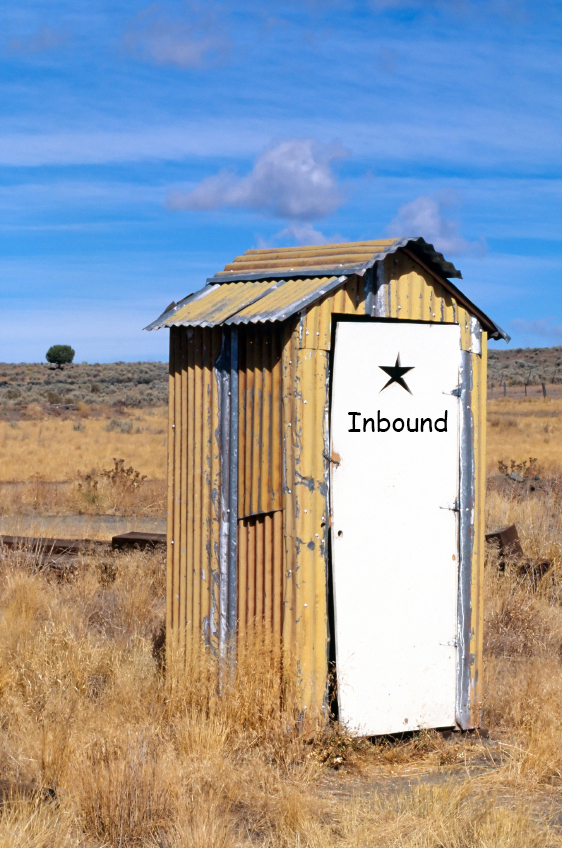
Many SEO love keyword-loaded domain names. The theory is that domains that feature a keyword will result in a boost in ranking. It’s still a contentious topic:
I’ve seen bloggers, webmasters and search aficionados argue the case around the death of EMDs time and time again, despite the evidence staring them in the face: EMDs are still all over the place. What’s more, do a simple bulk backlink analysis via Majestic, and you will find tons which rank in the top 10 while surrounded by far more authoritative domains.
No matter what the truth of the matter as to the ranking value of EMDs, most would agree that finding the right language for describing and profiling our business is important.
Terminology Changes
Consider the term “startup”.
This term, which describes a new small business, feels like it has been around forever. Not so. Conduct a search on the time period 1995-1998 and you won’t find results for start-up:
It’s a word that has grown up with the web and sounds sexier than just business. Just like the word “consultant” or “boutique” sounds better than “mom and pop” or “1 person business”. (You must remember of course when “sanitation engineer” replaced “trash man”.) oI just did a search to see the use of the word startup from the period 1995 to 1998 and came up with zilch in terms of relation to business
Start up does sound sexier than “mom n pop” or “one person business”, or “a few stoner mates avoiding getting a job”. A pitch to a VC that described the business as a “mom n pop” may not be taken seriously, whereas calling it a startup will.
If we want to be taken seriously by our audience, then finding the audience’s language is important.
SEO or Digital Marketing Or…..?
Has SEO become a dirty word? Has it always been a dirty word?
SEO’s don’t tend to see it that way, even if they are aware of the negative connotations. They see SEO as a description of what they do. It’s always been a bit of a misnomer, as we don’t optimize search engines, but for whatever reason, it stuck.
The term SEO is often associated with spam. The ever-amiable Matt Cutts video’s could be accompanied by a stern, animated wagging finger and a “tut tut tut” subtext. The search engines frown on a lot when it comes to SEO. SEO is permanent frown territory. Contrast this with PPC. PPC does not have that negative connotation. There is no reputation issue in saying you’re a PPC provider.
Over the years, this propaganda exercise that has resulted in the “SEO questionable/PPC credible” narrative has been pretty effective. The spammer label, borrowed from the world of email spam, has not been a term the SEO has managed to shrug off. The search engines have even managed to get SEOs to use the term “spammer” as a point of differentiation. “Spam is what the other SEOs do. Not me, of course.” This just goes to show how effective the propaganda has been. Once SEOs used spam to describe their own industry, the fate of the term SEO was sealed. After all, you seldom hear doctors, lawyers and retailers defining what they do against the bad actors in their sector.
As traffic acquisition gets broader, encompassing PR and social media, new titles like Digital Marketer have emerged. These terms have the advantage of not being weighed down by historical baggage. I’m not suggesting people should name themselves one thing or the other. Rather, consider these terms in a strategic sense. What terms best describe who you are and what you do, and cast you in the best possible light to those you wish to serve, at this point in time?
The language moves.
Generic Name Or Brandable?
Keyword loaded names, like business.com, are both valuable and costly. The downside of such names, besides being costly, is they severely limit branding opportunities. The better search engines get, and the more people use social media and other referral channels, the less these generic names will matter.
What matters most in crowded markets is being memorable.
A memorable, unique name is a valuable search commodity. If that name is always associated with you and no one else, then you’ll always be found in the search results. SEMRush, MajesticSEO, and Mo are unlikely to be confused with other companies. “Search Engine Tools”, not so much.
Will the generic name become less valuable because generic names are perhaps only useful at the start of an industry? How mature is your industry? How can you best get differentiation in a crowded market through language alone?
The Strategy Behind Naming
Here are a few points to consider.
1. Start Early
Names are often an afterthought. People construct business plans. They think about how their website looks. They think about their target market. They don’t yet have a name. Try starting with a name and designing everything else around it. The name can set the tone of every other decision you make.
2. Positioning
In mature markets, differentiation is strategically important. Is your proposed name similar to other competitors names? Is it unique enough? If you’re in at the start of a new industry, would a generic, keyword loaded name work best? Is it time for a name change because you’ve got lost in the crowd? Has your business focus changed?
Does your name go beyond mere description and create an emotional connection with your audience? Names that take on their own meaning, like Amazon, are more likely to grow with the business, rather than have the business outgrow the name. Imagine if Amazon.com had called itself Books.com.
3. What Are You All About?
Are you a high-touch consultative company? Or a product based, functional company? Are you on the cutting edge? Or are you catering to a market who like things just the way they are?
Writing down a short paragraph about how you see yourself, how the customers see you, and your position in the market, will help you come up with suitable names. Better yet, write a story.
4. Descriptive Vs Differentiation
Descriptive can be safe. “Internet Search Engine” or “Web Crawler”. There’s no confusing what those businesses do. Compare them with the name Google. Google gives you no idea what the company does, but it’s more iconic, quirky and memorable. There’s no doubt it has grown with the company and become a natural part of their identity in ways that “Internet Search Engine” never could.
Sometimes, mixing descriptions to create something quirky works well. Airbnb is a good example. The juxtaposition of those two words creates something new, whilst at the same time having a ring of the familiar. It’s also nice to know if the domain name is available, and if the name can be trademarked. The more generic the name, the harder it is to trademark, and the less likely the domain name is available.
5. Does Your Name Travel Well?
Hopefully, your name isn’t a swear word in another culture. Nor have negative connotations. Here are a few comical examples where it went wrong:
Nokia’s new smartphone translates in Spanish slang to prostitute, which is unfortunate, but at least the cell phone giant is in good company. The name of international car manufacturer Peugeot translates in southern China to Biao zhi, which means the same thing.
This is not such an issue if your market is local, but if you plan to expand into other markets in future, then it pays to consider this angle.
6. There’s No Right Answer
There is probably no universally good name. At least, when you first come up with a name, you can be assured some people will hate it, some will be indifferent, and some will like it – no matter what name you choose.
This is why it’s important to ground the subjective name-choosing process in something concrete, like your business strategy, or positioning in the market. You name could have come before the business plan. Or it could reflect it. You then test your name with people who will likely buy your product or service. It doesn’t matter what your Mom or your friends think of the name, it’s what you think of the name and what your potential customers think of the name that counts.
7. Diluting Your Name
Does each service line and product in your company need a distinctive name? Maybe, but the risk is that it could dilute the brand. Consider Virgin. They put the exact same name on completely different service lines. That same brand name carries the values and spirit of Virgin to whatever new enterprise they undertake. This also reduces the potential for customer confusion.
Creating a different name for some of your offerings might be a good idea, Say, if you’re predominantly a service-based company, yet you also have one product that you may spin off at some point in future. You may want to clearly differentiate the product from the service so as not to dilute the focus of the service side. Again, this is where strategy comes in. If you’re clear about what your company does, and your position in the market, then it becomes easier to decide how to name new aspects of your business. Or whether you should give them a name at all.
7. Is your name still relevant?
Brands evolve. They can appear outdated if the market moves on. On the other hand, they can built equity through longevity. It seems especially difficult to change internet company names as the inbound linking might be compromised as a result. Transferring the equity of a brand is typically expensive and difficult. All the more reason to place sufficient importance on naming to begin with.
8. More Than A Name
The branding process is more than just a name and identity. It’s the language of your company. It’s the language of your customers. It becomes a keyword on which people search. Your customers have got to remember it. You, and your employees, need to be proud of it. It sets you apart.
The language is important. And strategic.
Pandas, Penguins, and Popsicles
Are you still working through your newsfeed of SEO material on the 101 ways to get out of panda 4.0 written by people that have never actually practiced SEO on their own sites? Aaron and I had concluded that what was rolling through was panda before it was announced that it was panda, but I’m not going to walk here on my treadmill and knock out yet another post on the things you should be doing if you were gut punched by that negative a priori algorithm (hat tip to Terry, another fine SEObook member, for pointing out to me those public discussions that showed the philosophical evolutionary shift towards the default assumption that sites likely deserve to be punished). I’d say 90% of those posts are thinly veiled sales pitches; I should know since I sell infographics to support my nachos habit. Speaking of infographics, there’s already a great one that covers recovery strategies that still work right here.
Should I write about penguin? Analysis of that beast consumed the better part of 2 year years of my waking time. Nope. Again, I think it has already been adequately covered in a previous blog post. There’s nothing particularly new to report there either since the next update may be completely different, might be just another refresh that doesn’t take into account those slapped in the 1.0 incarnation of the update, or may actually be the penguin everyone hopes it is, taking into account the countless hours agencies have spent disavowing links and spamming me with fake legal threads should I not remove links they themselves placed. I wouldn’t hold your breathe on that last one. Outside of crowdsourcing pain for future manual penalties, I don’t expect much relief on that front.
Instead, I think I’m going to talk about popsicles. That seems like the kind of tripe that a SEO blog might discuss. I bet I can make it work though. I’m a fat dude in the Phoenix area and we already had our first 100F day, so I’m thinking of frozen treats. Strap in.
Search tactics and I’d even go so far as to say even certain strategies are like popsicles. When they are brand new they are cool and refreshing, but once exposed to the public heat they fade…fast. Really fast. Like a goop of sticky mess, which users of ALN and BMR can probably tell you.
Bear with me.
If you have a tactic that works, why would you expose it to the public? Nothing good can come of that. Sure, you have a tactic that works 100% but since I’m a loyal subscriber you’re willing to share it with me for $297. Seems legit. I’m not saying all services/products pitched this way are inherently ‘bad’, I’m just saying you aren’t going to get a magic bullet, yet alone one hand-wrapped and delivered by filling out a single wufoo form…sans report.
Would you share with a really close friend? I suppose, but even still the popsicle isn’t going to last as long since it is now being consumed at an accelerated rate. There’s the thought of germs, contamination, and other nasty thoughts that’d prevent me from going down that route. Cue the “Two SEOs, one popsicle” reaction videos. No. There are two ways to make the best use out of that popsicle.
- Practionioner: eat it quietly, savor it, make it last.
- Strategist w/ resources: figure out the recipe and mass produce it as quickly as possible, knowing that after enough public heat is on, the popsicles will start melting before they can be eaten, and no one likely that weird, warm orange sticky stuff that tastes like a glucose intolerance test.
There’s another caveat to the two above scenarios. Even if you’re a strategist with deep resources, unless you’re willing to test on your own sites, you’re just effectively selling smoke on an unproven tactic.
So there you have it, tactics are like popsicles. Disappointed? Good. I’ve been doing SEO since 1997, so here’s a secret: try to create engaging content, supported by authoritative off-page signals. There’s an ebb and flow to this of course, but it can be translated across the full black/white spectrum. Markov content in a free wordpress theme can be engaging when it is cloaked with actionable imagery, with certain % of back-buttons disabled, or when you make the advertising more compelling than the content (just ask eHow). Similarly, well-researched interactive infographics can engage the user on the other side of the spectrum…just more expensive. Comment spam and parasitic hosting on “authority” sites can tap into those authority signals on dark side, as can a thorough native campaign across a bunch of relevant sites backed by a PR campaign, TV commercials, and radio spots for the light side. Budget and objectives are the only difference.
Go enjoy a popsicle everyone. Summer is here; I expect a lot more heat from Google, so you might need one.
About the author: Joe Sinkwitz is the Chief Revenue Officer at CopyPress. He {Tweets / posts / comments / shares his thoughts} on navigating the evolving SEO landscape on Twitter here.
Please Remove My Link. Or Else.
Getting links removed is a tedious business.
It’s just as tedious for the site owner who must remove the links. Google’s annoying practice of “suggesting” webmasters jump through hoops in order to physically remove links that the webmaster suspects are bad, rather than Google simply ignoring the links that they’ve internally flagged, is causing frustration.
Is it a punitive punishment? If so, it’s doing nothing to endear Google to webmasters. Is it a smokescreen? i.e. they don’t know which links are bad, but by having webmasters declare them, this helps Google build up a more comprehensive database? Bit of both? It might also be adding costs to SEO in order to put SEO out of reach of small companies. Perhaps it’s a red herring to make people think links are more important than they actually are.
Hard to be sure.
Collateral Damage
SEOs are accustomed to search engines being coy, punitive and oblique. SEOs accept it as part of the game. However, it becomes rather interesting when webmasters who are not connected to SEO get caught up in the collateral damage:
I received an interesting email the other day from a company we linked to from one of our websites. In short, the email was a request to remove links from our site to their site. We linked to this company on our own accord, with no prior solicitation, because we felt it would be useful to our site visitors, which is generally why people link to things on the Internet.
And check out the subsequent discussion on Hacker News. Matt Cutts first post is somewhat disingenuous:
Situation #1 is by far the most common. If a site gets dinged for linkspam and works to clean up their links, a lot of them send out a bunch of link removal requests on their own prerogative
Webmasters who receive the notification are encouraged by Google to clean up their backlinks, because if they don’t, then their rankings suffer.
But, essentially from our point of view when it comes to unnatural links to your website we want to see that you’ve taken significant steps to actually remove it from the web but if there are some links that you can’t remove yourself or there are some that require payment to be removed then having those in the disavow file is fine as well.
(Emphasis mine)
So, of course webmasters who have received a notification from Google are going to contact websites to get links removed. Google have stated they want to see that the webmaster has gone to considerable effort to remove them, rather than simply use the disavow tool.
The inevitable result is that a webmaster who links to anyone who has received a bad links notification may receive the latest form of email spam known as the “please remove my link” email. For some webmasters, this email has become more common that the “someone has left you millions in a Nigerian bank account” gambit, and is just as persistent and annoying.
From The Webmasters Perspective
Webmasters could justifiably add the phrase “please remove my link” and the word “disavow” to their spam filters.
Let’s assume this webmaster isn’t a bad neighbourhood and is simply caught in the cross-fire. The SEO assumes, perhaps incorrectly, the link is bad and requests a take-down. From the webmasters perspective, they incur a time cost dealing with the link removal requests. A lone request might take a few minutes to physically remove – but hang on a minute – how does the webmaster know this request is coming from the site owner and not from some dishonest competitor? Ownership takes time to verify. And why would the webmaster want to take down this link, anyway? Presumably, they put it up because they deemed it useful to their audience. Or, perhaps some bot put the link there – perhaps as a forum or blog comment link – against the webmasters wishes – and now, to add insult to injury, the SEO wants the webmaster to spend his time taking it down!
Even so, this might be okay if it’s only one link. It doesn’t take long to remove. But, for webmasters who own large sites, it quickly becomes a chore. For large sites with thousands of outbound links built up over years, removal requests can pile up. That’s when the spam filter kicks in.
Then come the veiled threats. “Thanks for linking to us. This is no reflection on you, but if you don’t remove my link I’ll be forced to disavow you and your site will look bad in Google. I don’t want to do this, but I may have to.”
What a guy.
How does the webmaster know the SEO won’t do that anyway? Isn’t that exactly what some SEO conference speakers have been telling other SEOs to do regardless of whether the webmaster takes the link down or not?
So, for a webmaster caught in the cross-fire, there’s not much incentive to remove links, especially if s/he’s read Matt’s suggestion:
higherpurpose, nowhere in the original article did it say that Google said the link was bad. This was a request from a random site (we don’t know which one, since the post dropped that detail), and the op can certainly ignore the link removal request.
In some cases Google does specify links:
We’ve reviewed the links to your site and we still believe that some of them are outside our quality guidelines.
Sample URLs:
ask.metafilter.com/194610/get-me-and-my-stuff-from-point-a-to-point-b-possibly-via-point-cPlease correct or remove all inorganic links, not limited to the samples provided above. This may involve contacting webmasters of the sites with the inorganic links on them.
And they make errors when they specify those links. They’ve flagged DMOZ & other similar links: “Every time I investigate these “unnatural link” claims, I find a comment by a longtime member of MetaFilter in good standing trying to help someone out, usually trying to identify something on Ask MetaFilter.”
Changing Behaviour
Then the webmaster starts thinking.
“Hmmm…maybe linking out will hurt me! Google might penalize me or, even worse, I’ll get flooded with more and more “please remove my link” spam in future.”
So what happens?
The webmaster becomes very wary about linking out. David Naylor mentioned an increasing number of sites adopting a “no linking” policy. Perhaps the webmaster no-follows everything as a precaution. Far from being the life-giving veins of the web, links are seen as potentially malignant. If all outbound links are made no-follow, perhaps the chance of being banned and flooded with “please remove my link”spam is reduced. Then again, even nofollowed links are getting removal requests.
As more webmasters start to see links as problematic, fewer legitimate sites receive links. Meanwhile, the blackhat, who sees their sites occasionally getting burned as a cost of doing business, will likely see their site rise as they’ll be the sites getting all the links, served up from their curated link networks.
A commenter notes:
The Google webspam team seems to prefer psychology over technology to solve the problem, especially recently. Nearly everything that’s come out of Matt Cutt’s mouth in the last 18 months or so has been a scare tactic.
IMO all this does is further encourage the development of “churn and burn” websites from blackhats who have being penalized in their business plan. So why should I risk all the time and effort it takes to generate quality web content when it could all come crashing down because an imperfect and overzealous algorithm thinks it’s spam? Or worse, some intern or non-google employee doing a manual review wrongly decides the site violates webmaster guidelines?
And what’s the point of providing great content when some competitor can just take you out with a dedicated negative SEO campaign, or if Google hits you with a false positive? If most of your traffic comes from Google, then the risk of the web publishing model increases.
Is Google broken? Or is your site broken? That’s the question any webmaster asks when she sees her Google click-throughs drop dramatically. It’s a question that Matt Haughey, founder of legendary Internet forum MetaFilter, has been asking himself for the last year and a half, as declining ad revenues have forced the long-running site to lay off several of its staff.
Then again, Google may just not want what MetaFilter has to offer anymore.
(In)Unintended Consequences
Could this be uncompetitive practice from Google? Are the sites getting hit with penalties predominantly commercial sites? It would be interesting to see how many of them are non-commercial. If so, is it a way to encourage commercial sites to use Adwords as it becomes harder and harder to get a link by organic means? If all it did was raise the cost of doing SEO, it would still be doing its job.
I have no idea, but you could see why people might ask that question.
Let’s say it’s benevolent and Google is simply working towards better results. The unintended consequence is that webmasters will think twice about linking out. And if that happens, then their linking behaviour will start to become more exclusive. When links become harder to get and become more problematic, then PPC and social-media is going to look that much more attractive.
Google Helpouts Twitter Spam (Beta)
Google is desperate to promote Helpouts. I first realized this when I saw the following spam message in my email inbox.
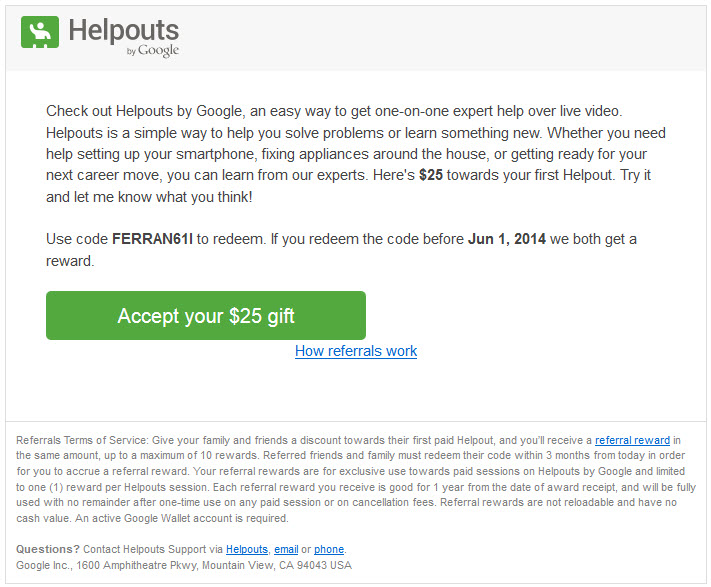
Shortly after a friend sent me a screenshot of a onebox promoting Helpouts in the SERPs.
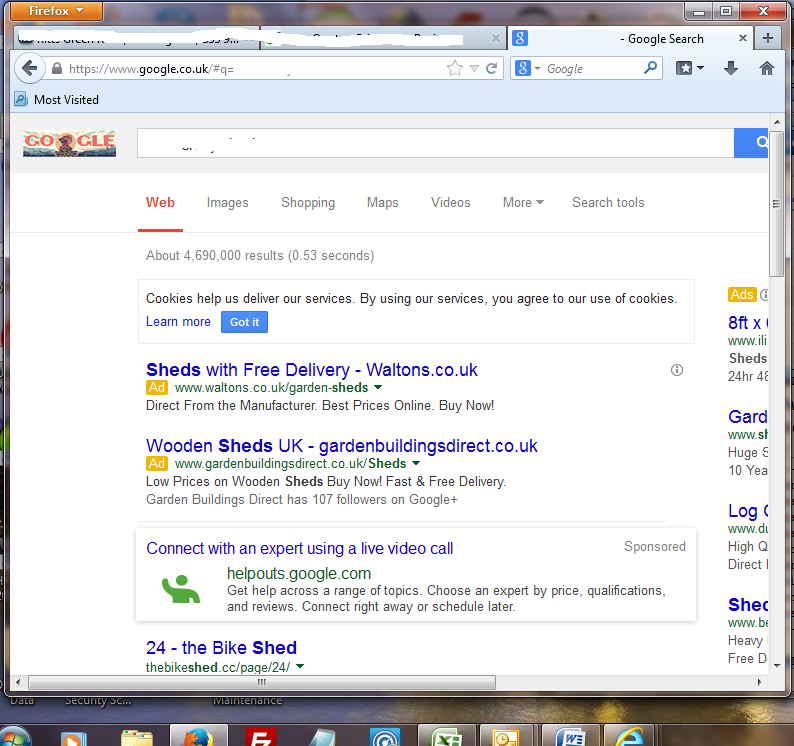
That’s Google monopoly and those are Google’s services. It is not like they are:
- being anti-competitive
- paying others to spam other websites
Let’s slow down though. Maybe I am getting ahead of myself:
Google has its own remote technology support service similar to Mr. Gupta’s called Google Helpouts. Mr. Gupta’s complaint alleges Google may have been blocking his advertisements so Google Helpouts could get more customers.
Oh, and that first message looked like it could have been an affiliate link. Was it?
Hmm
Let me see
What do we have here?
Google Helpouts connects you to a variety of experts–from doctors, parenting experts, tutors, personal trainers, and more–over live video call. The Google Helpouts Ambassador Program is a unique opportunity to spread the word about Helpouts, earn money, and influence a new Google product–all on your own schedule.
As an Ambassador, you will:
- Earn extra income–receive $25 for each friend you refer who takes their first paid Helpout, up to $1,000 per month for the first 4 months.
- Give direct feedback and help shape a new Google product
- Join a community of innovative Ambassadors around the country
- Receive a Helpouts gift and the chance to win prizes
We all know HELPFUL hotel affiliate websites are spam, but maybe Google HELPouts affiliate marketing isn’t spam.
After all, Google did promise to teach people how to do their affiliate marketing professionally: “We will provide you with an Ambassador Toolkit with tips and suggestions on creative ways you can spread the word. You are encouraged to get creative, be innovative, and utilize different networks (i.e. social media, word of mouth, groups & associations, blogs, etc.) to help you.”
Of course the best way to lead is by example.
And lead they do.
They are highly inclusive in their approach.
@homosexualwentz Help is here! Use the code IFOUNDHELP for $20 off a 1-on-1 session w/ a trusted tech expert today: http://t.co/OtiePzjOIS— Helpouts by Google (@Helpouts) May 12, 2014
Check out this awesome Twitter usage
They’ve more Tweets in the last few months than I’ve made in 7 years. There are 1,440 minutes in a day, so it is quite an achievement to make over 800 Tweets in a day.
@Helpouts did google helpouts really just reply to a tweet of mine?— Emma Klinger (@Emma_Klinger) May 15, 2014
You and many many many many thousands of others, Emma.
Some minutes they are making 2 or 3 Tweets.
And with that sort of engagement & the Google brand name, surely they have built a strong following.
Uh, nope.
They are following over 500 people and have about 4,000 followers. And the 4,000 number is generous, as some of them are people who sell on that platform or are affiliates pushing it.

Let’s take a look at the zero moment of truth:
@Helpouts I really don’t want to pay for support.— Krishna M. Sadasivam (@pcweenies) May 14, 2014
Thanks for your unsolicited commercial message, but I am not interested.
@baileyboo612 @Helpouts what the heck??— logan™ (@logangaspard) May 13, 2014
You’re confusing me. Some context would help.
@Helpouts Hi, who can help me? , do u have an email for talk there?— Pamela López (@karlismkt) May 15, 2014
No email support, but support “sessions”? What is this?
@Helpouts $1.00 a minute? No thanks…— (@Owennn_Marsh) May 14, 2014
Oh, I get it now. Is this a spam bot promoting phone sex?
RT “@Helpouts: Help is just a click away! Helpouts by #Google has Apple tech experts who can help out today.” … No, just no— Johnny Blanchard (@JonnBlanchard) May 15, 2014
Ah, so it isn’t phone sex, but you can help with iPhones. Um, did we forget that whole Steve Jobs thermonuclear war bit? And why is Google offering support for Apple products when Larry Page stated the whole idea of customer support was ridiculous?
@Helpouts MAN I’VE ALREADY TRIED GOOGLE— mya ☪ (@gleebegay) May 15, 2014
OK, so maybe this is more of the same.
@Helpouts hahaha I’m not going to pay money for things that probably won’t even help me.— Nate Morse (@nt4343) May 16, 2014
Cynical, aren’t we?
@Helpouts no, that’s too expensive— Mahalah (@Mahalah_faye) May 16, 2014
And cheap?
@Helpouts im not paying— ononnah❄ (@ononnahh) May 15, 2014
Really cheap. :(
@Helpouts fu I’m not paying for help— Sam (@ttihweimmas) May 14, 2014
And angry?
@Helpouts Chill out!— Atsuro Kihara (@atsuro_enbot) May 15, 2014
And testy?
@Helpouts then why the fuck arent you fixing my mentions if youre such “trusted tech experts”— bianca // KIAN 4/6?? (@lawlorfflower) May 13, 2014
And rude?
@Helpouts no— Abby Williams (@abbywilliams96) May 15, 2014
And curt?
@Helpouts no— spongebobs weave (@googlingcraic) May 15, 2014
Didn’t you already say that???
@Helpouts fuck you— Samuel (@SamuelJones69) May 14, 2014
Didn’t you already say that???
@Helpouts what the heck— hey cal (@holycalum) May 14, 2014
It seems we are having issues communicating here.
@Helpouts ok I fucks with it. Next time try not to spy on my tweets lol— E (@Easy_Eli) May 14, 2014
I’m not sure it is fair to call it spying a half day late.
That was 11 hours ago @Helpouts pic.twitter.com/jRVV7rgtdW— 28 (@5SOSmaryam) May 14, 2014
Better late than never.
@Helpouts I fixed it already maybe? Thank you tho automatic message— Megar (@AH_Megan6) May 15, 2014
Even if automated.
Good catch Megar, as Google has a creepy patent on automating social spam.
@Helpouts Sorry, but I’ll just ask my friends because they are free and I need to do the homework right now.— Emma Raye Mosier (@EmmaRayeMosier) May 15, 2014
Who are your real Google+ friends? Have they all got the bends? Is Google really sinking this low?
@Helpouts Classmates over corporations, Google. I’m not interested.
BTW please don’t censor the European internet.— Hash (@saikorhythm) May 15, 2014
Every journey of a thousand miles begins with a single step.
@Helpouts This is hilarious. If I ever need it I know you guys have this, thanks!— Gabriella (@Gaby441) May 14, 2014
Humorous or sad…depending on your view.
@Helpouts thanks! is there also a Helpout on how to shameless self promote yourself through twitter? just wondering— Etta Grover (@ettafetacheese) May 14, 2014
There’s no wrong way to eat a Reese’s.
Google has THOUSANDS of opportunities available for you to learn how to spam Twitter.
As @Helpouts repeatedly Tweets: “Use the code IFOUNDHELP for $20 off” :D
++++++++
All the above Tweets were from the last few days.
The same sort of anti-social agro spamming campaign has been going on far longer.
@Helpouts fuck off— Dagger Anderson (@daggeranderson) May 8, 2014
When Twitter users said “no thank you”…
@Helpouts THIS SHIT AINT FREE— mariam / 20 (@psychoticamila) May 8, 2014
…Google quickly responded like a Marmaris rug salesman
@Helpouts leave me a lone— mariam / 20 (@psychoticamila) May 9, 2014
Google has a magic chemistry for being able to…
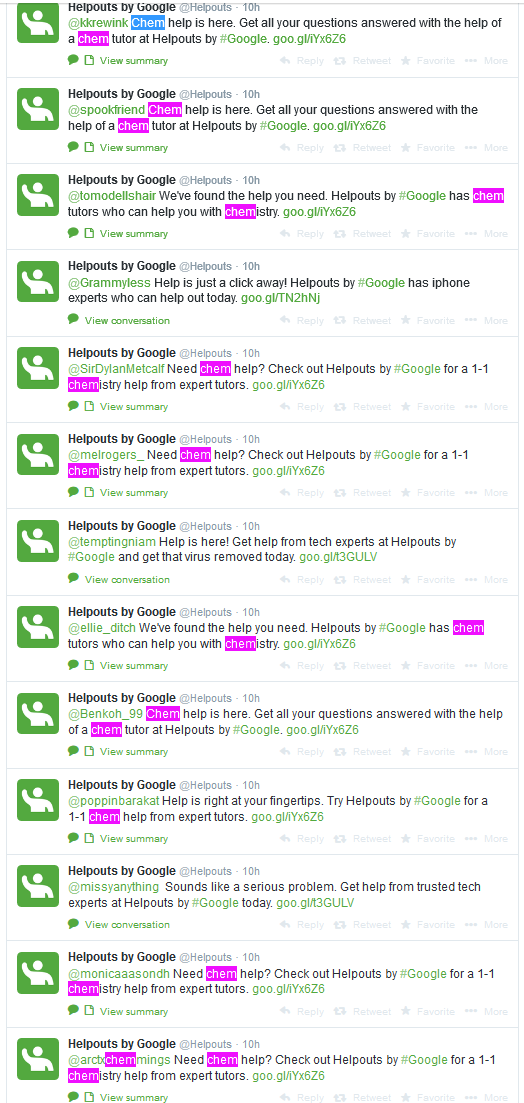
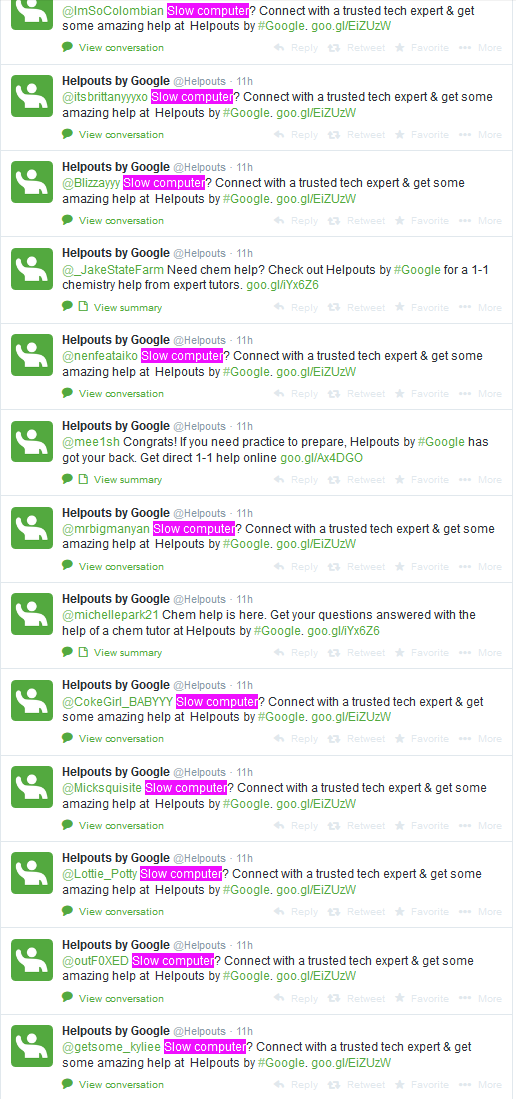
We need to fight spam messages (with MOAR spam messages).
@shelleyamybeth Lets try to get rid of all those Spam messages. Check out #Helpouts by Google for Wordpress help. http://t.co/eTTOMnpIhF— Helpouts by Google (@Helpouts) March 25, 2014
In a recent Youtube video Matt Cutts said: “We got less spam and so it looks like people don’t like the new algorithms as much.” Based on that, perhaps we can presume Helpouts is engaging in a guerrilla marketing campaign to improve user satisfaction with the algorithms.
Or maybe Google is spamming Twitter so they can justify banning Twitter.
Or maybe this is Google’s example of how we should market websites which don’t have the luxury of hard-coding at the top of the search results.
Or maybe Google wasn’t responsible for any of this & once again it was “a contractor.”
What’s Wrong With A/B Testing

A/B testing is an internet marketing standard. In order to optimize response rates, you compare one page against another. You run with the page that gives you the best response rates.
But anyone who has tried A/B testing will know that whilst it sounds simple in concept, it can be problematic in execution. For example, it can be difficult to determine if what you’re seeing is a tangible difference in customer behaviour or simply a result of chance. Is A/B testing an appropriate choice in all cases? Or is it best suited to specific applications? Does A/B testing obscure what customers really want?
In this article, we’ll look at some of the gotchas for those new to A/B testing.
1. Insufficient Sample Size
You set up test. You’ve got one page featuring call to action A and one page featuring call to action B. You enable your PPC campaign and leave it running for a day.
When you stop the test, you’ve found call-to-action A converted at twice the rate of call-to-action B. So call-to-action A is the winner and we should run with it, and eliminate option B.
But this would be a mistake.
The sample size may be insufficient. If we only tested one hundred clicks, we might get a significant difference in results between two pages, but that change doesn’t show up when we get to 1,000 clicks. In fact, the result may even be reversed!
So, how do we determine a sample size that is statistically significant? This excellent article explains the maths. However, there are various online sample size calculators that will do the calculations for you, including Evan’s. Most A/B tracking tools will include sample size calculators, but it’s a good idea to understand what they’re calculating, and how, to ensure the accuracy of your tests.
In short, make sure you’ve tested enough of the audience to determine a trend.
2. Collateral Damage
We might want to test a call to action metric. We want to test the number of people who click on the “find out more” link on a landing page. We find that a lot more people click on this link we use the term “find out more” than if we use the term “buy now”.
Great, right?
But what if the conversion rate for those who actually make a purchase falls as a result? We achieved higher click-thrus on one landing page at the expense of actual sales.
This is why it’s important to be clear about the end goal when designing and executing tests. Also, ensure we look at the process as a whole, especially when we’re chopping the process up into bits for testing purposes. Does a change in one place affect something else further down the line?
In this example, you might A/B test the landing page whilst keeping an eye on your total customer numbers deeming the change effective only if customer numbers also rise. If your aim was only to increase click-thru, say to boost quality scores, then the change was effective.
3. What, Not Why
In the example above, we know the “what”. We changed the wording of a call-to-action link, and we achieved higher click thru’s, although we’re still in the dark as to why. We’re also in the dark as to why the change of wording resulted in fewer sales.
Was it because we attracted more people who were information seekers? Were buyers confused about the nature of the site? Did visitors think they couldn’t buy from us? Were they price shoppers who wanted to compare price information up front?
We don’t really know.
But that’s good, so long as we keep asking questions. These types of questions lead to more ideas for A/B tests. By turning testing into an ongoing process, supported by asking more and hopefully better questions, we’re more likely to discover a whole range of “why’s”.
4. Small Might Be A Problem
If you’re a small company competing directly with big companies, you may already be on the back foot when it comes to A/B testing.
It’s clear that its very modularity can cause problems. But what about in cases where the number of tests that can be run at once is low? While A/B testing makes sense on big websites where you can run hundreds of tests per day and have hundreds of thousands of hits, only a few offers can be tested at one time in cases like direct mail. The variance that these tests reveal is often so low that any meaningful statistical analysis is impossible.
Put simply, you might not have the traffic to generate statistically significant results. There’s no easy way around this problem, but the answer may lay in getting tricky with the maths.
Experimental design massively and deliberately increases the amount of variance in direct marketing campaigns. It lets marketers project the impact of many variables by testing just a few of them. Mathematical formulas use a subset of combinations of variables to represent the complexity of all the original variables. That allows the marketing organization to more quickly adjust messages and offers and, based on the responses, to improve marketing effectiveness and the company’s overall economics
Another thing to consider is that if you’re certain the bigger company is running A/B tests, and achieving good results, then “steal” their landing page*. Take their ideas for landing pages and use that as a test against your existing pages. *Of course, you can’t really steal their landing page, but you can be “influenced by” their approach.
What your competitors do is often a good starting point for your own tests. Try taking their approach and refine it.
5. Might There Be A Better Way?
Are there alternatives to A/B testing?
Some swear by the Multi Armed Bandit methodology:
The multi-armed bandit problem takes its terminology from a casino. You are faced with a wall of slot machines, each with its own lever. You suspect that some slot machines pay out more frequently than others. How can you learn which machine is the best, and get the most coins in the fewest trials?
Like many techniques in machine learning, the simplest strategy is hard to beat. More complicated techniques are worth considering, but they may eke out only a few hundredths of a percentage point of performance.
Then again…..
What multi-armed bandit algorithm does is that it aggressively (and greedily) optimizes for currently best performing variation, so the actual worse performing versions end up receiving very little traffic (mostly in the explorative 10% phase). This little traffic means when you try to calculate statistical significance, there’s still a lot of uncertainty whether the variation is “really” worse performing or the current worse performance is due to random chance. So, in a multi-armed bandit algorithm, it takes a lot more traffic to declare statistical significance as compared to simple randomization of A/B testing. (But, of course, in a multi-armed bandit campaign, the average conversion rate is higher).
Multivariate testing may be suitable if you’re testing a combination of variables, as opposed to just one i.e.
- Product Image: Big vs. Medium vs Small
- Price Text Style: Bold vs Normal
- Price Text Color: Blue vs. Black vs. Red
There would be 3x2x3 different versions to test.
The problem with multivariate tests is they can get complicated pretty quickly and require a lot of traffic to produce statistically significant results. One advantage of multivariate testing over A/B testing is that it can tell you which part of the page is most influential. Was it a graphic? A headline? A video? If you’re testing a page using an A/B test, you won’t know. Multivariate testing will tell you which page sections influence the conversion rate and which don’t.
6. Methodology Is Only One Part Of The Puzzle
So is A/B testing worthwhile? Are the alternatives better?
The methodology we choose will only be as good as the test design. If tests are poorly designed, then the maths, the tests, the data and the software tools won’t be much use.
To construct good tests, you should first take a high level view:
Start the test by first asking yourself a question. Something on the lines of, “Why is the engagement rate of my site lower than that of the competitors…..Collect information about your product from customers before setting up any big test. If you plan to test your tagline, run a quick survey among your customers asking how they would define your product.
Secondly, consider the limits of testing. Testing can be a bit of a heartless exercise. It’s cold. We can’t really test how memorable and how liked one design is over the other, and typically have to go by instinct on some questions. Sometimes, certain designs just work for our audience, and other designs don’t. How do we test if we’re winning not just business, but also hearts and minds?
Does it mean we really understand our customers if they click this version over that one? We might see how they react to an offer, but that doesn’t mean we understand their desires and needs. If we’re getting click-backs most of the time, then it’s pretty clear we don’t understand the visitors. Changing a graphic here, and wording there, isn’t going to help if the underlying offer is not what potential customers want. No amount of testing ad copy will sell a pink train.
The understanding of customers is gained in part by tests, and in part by direct experience with customers and the market we’re in. Understanding comes from empathy. From asking questions. From listening to, and understanding, the answers. From knowing what’s good, and bad, about your competitors. From providing options. From open communication channels. From reassuring people. You’re probably armed with this information already, and that information is highly useful when it comes to constructing effective tests.
Do you really need A/B testing? Used well, it can markedly improve and hone offers. It isn’t a magic bullet. Understanding your audience is the most important thing. Google, a company that uses testing extensively, seem to be most vulnerable when it comes to areas that require a more intuitive understanding of people. Google Glass is a prime example of failing to understand social context. Apple, on the other hand, were driven more by an intuitive approach. Jobs: “We built [the Mac] for ourselves. We were the group of people who were going to judge whether it was great or not. We weren’t going to go out and do market research”
A/B testing is can work wonders, just so long as it isn’t used as a substitute for understanding people.
Learn Local Search Marketing
Last October Vendran Tomic wrote a guide for local SEO which has since become one of the more popular pages on our site, so we decided to follow up with a QnA on some of the latest changes in local search.
Q: Google appears to have settled their monop…
Google’s Effective ‘White Hat’ Marketing Case Study
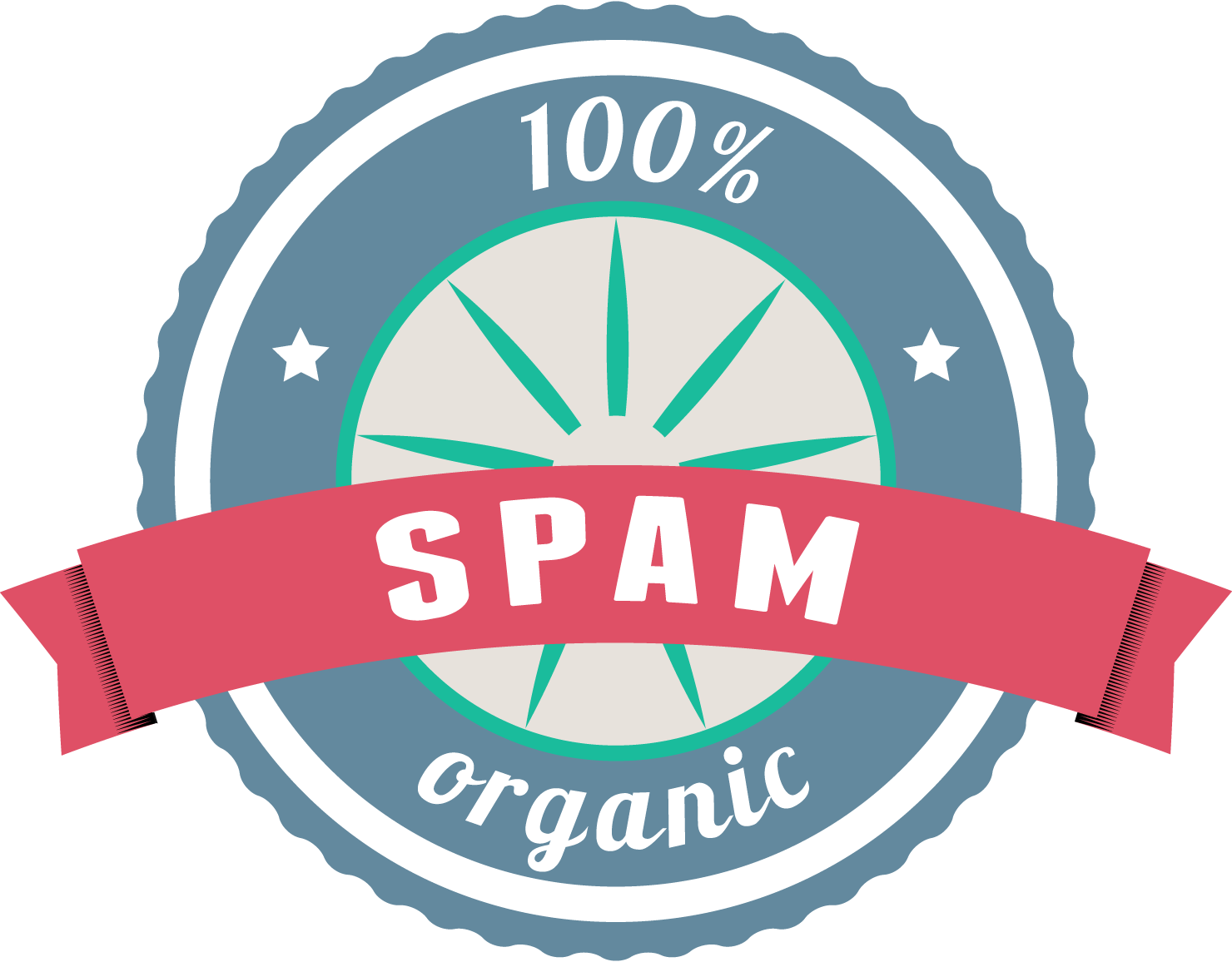
There’s the safe way & the high risk approach. The shortcut takers & those who win through hard work & superior offering.
One is white hat and the other is black hat.
With the increasing search ecosystem instability over the past couple years, some see these labels constantly sliding, sometimes on an ex-post-facto basis, turning thousands of white hats into black hats arbitrarily overnight.
Are you a white hat SEO? or a black hat SEO?
Do you even know?
Before you answer, please have a quick read of this Washington Post article highlighting how Google manipulated & undermined the US political system.
.
.
.
.
.
.
.
Seriously, go read it now.
It’s fantastic journalism & an important read for anyone who considers themselves an SEO.
.
.
.
.
.
.
.
.
######
Take the offline analog to Google’s search “quality” guidelines & in spirit Google repeatedly violated every single one of them.
Advertorials
creating links that weren’t editorially placed or vouched for by the site’s owner on a page, otherwise known as unnatural links can be considered a violation of our guidelines. Advertorials or native advertising where payment is received for articles that include links that pass PageRank
Advertorials are spam, except when they are not: “the staff and professors at GMU’s law center were in regular contact with Google executives, who supplied them with the company’s arguments against antitrust action and helped them get favorable op-ed pieces published“
Deception
Don’t deceive your users.
Ads should be clearly labeled, except when they are not: “GMU officials later told Dellarocas they were planning to have him participate from the audience,” which is just like an infomercial that must be labeled as an advertisement!
Preventing Money from Manipulating Editorial
Make reasonable efforts to ensure that advertisements do not affect search engine rankings. For example, Google’s AdSense ads and DoubleClick links are blocked from being crawled by a robots.txt file.
Money influencing outcomes is wrong, except when it’s not: “Google’s lobbying corps — now numbering more than 100 — is split equally, like its campaign donations, among Democrats and Republicans. … Google became the second-largest corporate spender on lobbying in the United States in 2012.”
Content Quality
The best way to get other sites to create high-quality, relevant links to yours is to create unique, relevant content that can naturally gain popularity in the Internet community. Creating good content pays off: Links are usually editorial votes given by choice, and the more useful content you have, the greater the chances someone else will find that content valuable to their readers and link to it.
Payment should be disclosed, except when it shouldn’t: “The school and Google staffers worked to organize a second academic conference focused on search. This time, however, Google’s involvement was not publicly disclosed.”
Cloaking
Cloaking refers to the practice of presenting different content or URLs to human users and search engines. Cloaking is considered a violation of Google’s Webmaster Guidelines because it provides our users with different results than they expected.
cloaking is evil, except when it’s not: Even as Google executives peppered the GMU staff with suggestions of speakers and guests to invite to the event, the company asked the school not to broadcast its involvement. “We will certainly limit who we announce publicly from Google”
…and on and on and on…
It’s not safe to assume that just because a specific deceptive technique isn’t included on this page, Google approves of it.
And while they may not approve of something, that doesn’t mean they avoid the strategy when mapping out their own approach.
There’s a lesson & it isn’t a particularly subtle one.
More and more, it looks like that invisible hand shaping the market actually belongs to Google. http://t.co/fFigz7lMSY— Matt Pearce (@mattdpearce) April 13, 2014
Free markets aren’t free. Who could have known?
The Positive Negative SEO Strategy

There’s a case study on Moz on how to get your site back following a link penalty. An SEO working on a clients site describes what happened when their client got hit with a link penalty. Even though the link penalty didn’t appear to be their fault, it still took months to get their rankings back.
Some sites aren’t that lucky. Some sites don’t get their rankings back at all.
The penalty was due to a false-positive. A dubious site links out to a number of credible sites in order to help disguise their true link target. The client site was one of the credible sites, mistaken by Google for a bad actor. Just goes to show how easily credible sites can get hit by negative SEO, and variations thereof.
There’s a tactic in there, of course.
Take Out Your Competitors
Tired of trying to rank better? Need a quicker way? Have we got a deal for you!
Simply build a dubious link site, point some rogue links at sites positioned above yours and wait for Google’s algorithm to do the rest. If you want to get a bit tricky, link out to other legitimate sites, too. Like Wikipedia. Google, even. This will likely confuse the algorithm for a sufficient length of time, giving your tactic time to work.
Those competitors who get hit, and who are smart enough to work out what’s going on, may report your link site, but, hey, there are plenty more link sites where that came from. Roll another one out, and repeat. So long as your link site can’t be connected with you – different PC, different IP address, etc – then what have you got to lose? Nothing much. What have your competitors got to lose? Rank, a lot of time, effort, and the very real risk they won’t get back into Google’s good books. And that’s assuming they work out why they lost rankings.
I’m not advocating this tactic, of course. But we all know it’s out there. It is being used. And the real-world example above shows how easy it is to do. One day, it might be used against you, or your clients.
Grossly unfair, but what can you do about it?
Defensive Traffic Strategy
Pleading to Google is not much of a strategy. Apart from anything else, it’s an acknowledgement that the power is not in your hands, but in the hands of an unregulated arbiter who likely views you as a bit of an annoyance. It’s no wonder SEO has become so neurotic.
It used to be the case that competitors could not take you out pointing unwanted links at you. No longer. So even more control has been taken away from the webmaster.
The way to manage this risk is the same way risk is managed in finance. Risk can be reduced using diversification. You could invest all your money in one company, or you could split it between multiple companies, banks, bonds and other investment classes. If you’re invested in one company, and they go belly up, you lose everything. If you invest in multiple companies and investment classes, then you’re not as affected if one company gets taken out. In other words, don’t put all your eggs in one basket.
It’s the same with web traffic.
1. Multiple Traffic Streams
If you only run one site, try to ensure your traffic is balanced. Some traffic from organic search, some from PPC, some from other sites, some from advertisements, some from offline advertising, some from email lists, some from social media, and so on. If you get taken out in organic search, it won’t kill you. Alternative traffic streams buy you time to get your rankings back.
2. Multiple Pages And Sites
A “web site” is a construct. Is it a construct applicable to a web that mostly orients around individual pages? If you think in terms of pages, as opposed to a site, then it opens up more opportunities for diversification.
Pages can, of course, be located anywhere, not just on your site. These may take the form of well written, evergreen, articles published on other popular sites. Take a look at the top sites in closely related niches and see if there are any opportunities to publish your content on them. Not only does this make your link graph look good, so long as it’s not overt, you’ll also have achieve more diversity.
Consider Barnacle SEO.
Will creatively defines the concept of barnacle SEO as follows:
Attaching oneself to a large fixed object and waiting for the customers to float by in the current.
Directly applied to local search, this means optimizing your profiles or business pages on a well-trusted, high-ranking directory and working to promote those profiles instead of — or in tandem with — your own website.“
You could also build multiple sites. Why have just one site when you can have five? Sure, there’s more overhead, and it won’t be appropriate in all cases, but again, the multiple site strategy is making a comeback due to Google escalating the risk of having only one site. This strategy also helps get your eggs into multiple baskets.
3. Prepare For the Worst
If you’ve got most of your traffic coming from organic search, then you’re taking a high risk approach. You should manage that risk down with diversification strategies first. Part of the strategy for dealing with negative SEO is not to make yourself so vulnerable to it in the first place.
If you do get hit, have a plan ready to go to limit the time you’re out of the game. The cynical might suggest you have a name big enough to make Google look bad if they don’t show you.
Lyrics site Rap Genius says that it is no longer penalized within Google after taking action to correct “unnatural links” that it helped create. The site was hit with a penalty for 10 days, which meant people seeking it by name couldn’t find it.
For everyone else, here’s a pretty thorough guide about how to get back in.
Have your “plead with Google” gambit ready to go at a moments notice. The lead time to get back into Google can be long, so the sooner you get onto it, the better. Of course, this is really the last course of action. It’s preferable not make yourself that vulnerable in the first place.
By diversifying.
Bing Lists ‘Alternatives’ In Search Results
Bing recently stated testing listing ‘alternatives’ near their local search results.
I wasn’t able to replicate these in other search verticals like flight search, or on an iPhone search, but the format of these alternatives looks similar to the forma…
Flip Guest Blogging on its Head, With Steroids
Guest blogging was once considered a widely recommended white hat technique.
Today our monopoly-led marketplace arbitrarily decided this is no longer so.
Stick a fork in it. Torch it. Etc.
It looks like MyBlogGuest was the “winner” – not appearing on branded terms RT @mattcutts Today we took action on a large guest blog network— Rae Hoffman (@sugarrae) March 19, 2014
Now that rules have changed ex post facto, we can expect to deal with a near endless stream of “unnatural” link penalties for doing what was seen at the time as being:
- natural
- widespread
- common
- low risk
- best practice
Google turns your past client investments into new cost centers & penalties. This ought to be a great thing for the SEO industry. Or maybe not.
As Google scares & expunges smaller players from participating in the SEO market, larger companies keep chugging along.
Today a friend received the following unsolicited email:
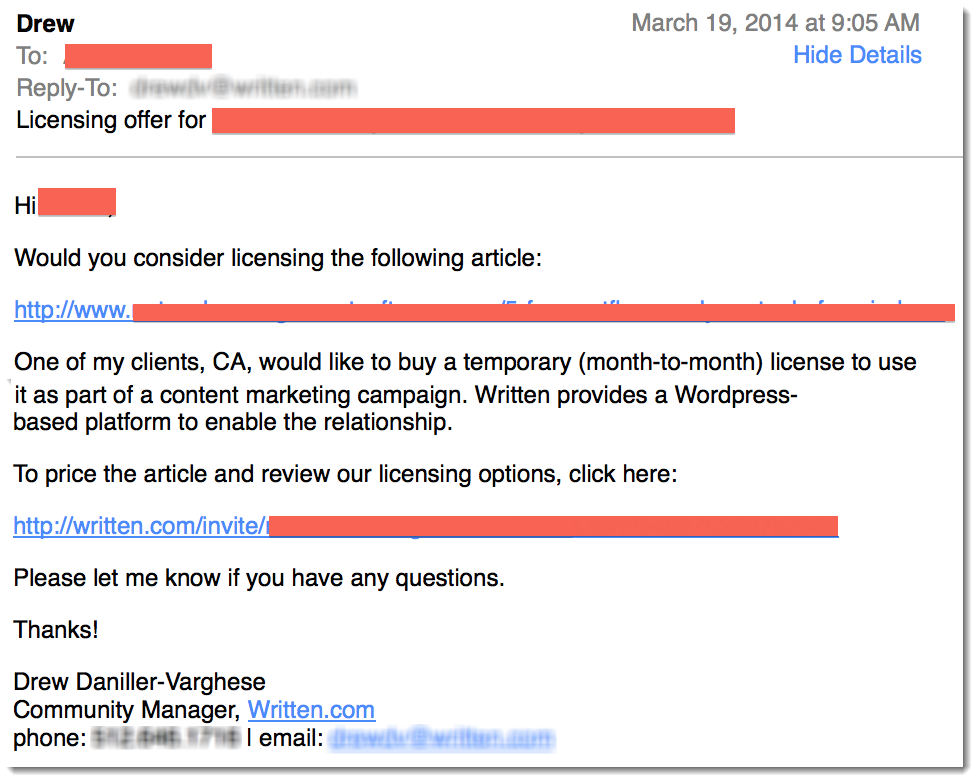
Curious about their background, he looked up their past coverage: “Written then offers a number of different content licenses that help the advertiser reach this audience, either by re-branding the existing page, moving the content to the advertiser’s website and re-directing traffic there, or just re-publishing the post on the brand’s blog.”
So that’s basically guest blogging at scale.
And it’s not only guest blogging at scale, but it is guest blogging at scale based on keyword performance:
“You give us your gold keywords. Written finds high-performing, gold content with a built-in, engaged audience. Our various license options can bring the audience to you or your brand to the audience through great content.”
What’s worse is how they pitch this to the people they license content from:
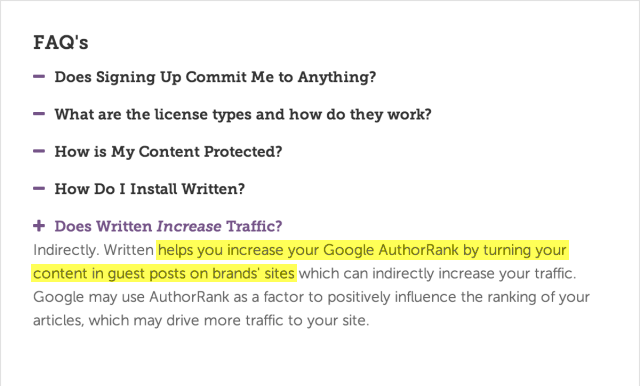
I’m sorry, but taking your most valuable content & turning it into duplicate content by syndicating it onto a fortune 500 website will not increase your traffic. The fortune 500 site will outrank you (especially if visitors are redirected to their site!). And when visitors are not redirected, they will still typically outrank you due to their huge domain authority, leading your content on your site to get filtered out of the search results as duplicate content.
And if Google were to come down on anyone in the above sort of situation it would be the smaller independent bloggers who get hit.
This is how SEO works.
Smaller independent players innovate & prove the model.
Google punishes them for being innovative.
And as they are getting punished, a vanilla corporate tweak of the same model rolls out and is white hat.
In SEO it’s not what you do that matters – it’s who your client is.
If you’re not working for a big brand, you’re doing it wrong.
Handling Objections From SEO Clients

If the current war on SEOs by Google wasn’t bad enough if you own the site you work on, then it is doubly so for the SEO working for a client. When the SEO doesn’t have sufficient control over the strategy and technology, it can be difficult to get and maintain rankings.
In this post, we’ll take a look at the challenges and common objections the SEO faces when working on a client site, particularly a client who is engaging an SEO for the first time. The SEO will need to fit in with developers, designers and managers who may not understand the role of SEOs. Here are common objections you can expect, and some ideas on how to counter them.
1. Forget About SEO
The objection is that SEO gets in the way. It’s too hard.
It’s true. SEO is complicated. It can often compromise design and site architecture. To managers and other web technicians, SEO can look like a dark art. Or possibly a con. There are no fixed rules as there are in, say, coding, and results are unpredictable.
So why spend time and money on SEO?
One appropriate response is “because your competitors are”
Building a website is the equivalent of taking the starting line in a race. Some site owners think that’s all they need do. However, the real race starts after the site is built. Every other competitor has a web site, and they’re already off and running in terms of site awareness. Without SEO, visitors may find a site, but if the site owner is not using the SEO channel, and their competitors are, then their competitors have an advantage in terms of reach.
2. Can’t SEOs Do Their Thing After The Site Is Built?
SEO’s can do their thing after the site is built, but it’s more difficult. As a result, it’s likely to be more expensive. Baking SEO into the mix when it is conceived and built is an easier route.
Just as copywriters require space to display their copy, SEO’s require room to manoeuvre. They’ll likely contribute to information architecture, copy, copy markup and internal linking structures. So start talking about SEO as early as possible, and particularly during information architecture.
There are three key areas where SEO needs to integrate with design. One, the requirement that text is machine readable. Search engines “think” mostly in terms of words, so topics and copy need to relate to search terms visitors may use.
Secondly, linking architecture and information hierarchies. If pages are buried deep in the site, but deemed important in terms of search, they will likely be elevated in the hierarchy to a position closer to the home page.
Thirdly, crawl-ability. A search engine sends out a spider, which grabs the source code of your website, and dumps it back in the search engines database. The spider skips from page to page, following links. If a page doesn’t have a crawlable link pointing to it, it will be invisible to search engines. There are various means of making a site easy to crawl, but one straightforward way is to use a site map, linked to from each page on the site. The SEO may also want to ensure the site navigation is crawlable.
3. We Don’t Want The SEO To Interfere With Code
SEO’s do need to tweak code, however the mark-up is largely inconsequential.
SEO’s need to specify title tags and some meta tags. These tags need to be unique for each page on the site, as each page is a possible entry page. A search visitor will not necessarily arrive at the home page first.
The title tag appears in search results as a clickable link, so serves a valuable marketing function. When search visitors consider which link on a search results page to click, the title tag and snippet will influence their decision. The title tag should, therefore, closely match the content of each page.
The second aspect concerns URL’s. Ideally, a URL should contain descriptive words, as opposed to numbers and random letters. For example, acme.com/widgets/red-widgets.htm is good, whilst acme.com/w/12345678&tnr.php, less so.
The more often the keyword appears, the more likely it will be bolded on a search results page, and is therefore more likely to attract a click. It’s also easier for the search engine to determine meaning if a URL is descriptive as opposed to cryptic.
4. I’ve Got An SEO PlugIn. That’s All I Need
SEO Plugins cover the on-site basics. But ranking well involves more than covering the basics.
In order to rank well, a page needs to have links from external sites. The higher quality those sites, the more chances your pages have of ranking well. The SEO will look to identify linking possibilities, and point these links to various internal pages on the site.
It can be difficult, near impossible, to get high quality links to brochure-style advertising pages. Links tend to be directed at pages that have unique value.
So, the type and quality of content has more to do with SEO than the way that content is marked up by a generic plugin. The content must attract links and generate engagement. The visitor needs to see a title on a search result, click through, not click back, and, preferably take some action on that page. That action may be a click deeper into the site, a bookmark, a tweet, or some other measurable form of response.
Content that lends itself to this type of interaction includes blog posts, news feeds, and content intended for social network engagement. In this way, SEO-friendly content can be functionally separated from other types of content. Not every page needs to be SEO’d, so SEO can be sectioned off, if necessary.
5. The SEO Is Just Another Technician
If your aim, or your clients aim, is to attract as much targeted traffic as possible then SEO integration must be taken just as seriously as design, development, copy and other media. SEO is more than a technical exercise, it’s a strategic marketing exercise, much like Public Relations.
SEO considerations may influence your choice of CMS. It may influence your strategic approach in terms of what type of information you publish. It may change the way you engage visitors. Whilst SEO can be bolted-on afterwards, this is a costly and less-effective way of doing SEO, much like re-designing a site is costly and less effective than getting it right in the planning stage.
6. Why Have Our Ranking Disappeared?
The reality of any marketing endeavour is that it will have a shelf-life. Sometimes, that shelf life is short. Other times, it can run for years.
SEO is vulnerable to the changes made by search engines. These changes aren’t advertised in advance, nor are they easily pinned down even after they have occurred. This is why SEO is strategic, just as Public Relations is strategic. The Public Relations campaign you were using a few years ago may not be the same one you use now, and the same goes for SEO.
The core of SEO hasn’t changed much. If you produce content visitors find relevant, and that content is linked to, and people engage with that content, then it has a good chance of doing well in search engines. However, the search engines constantly tweak their settings, and when they do, a lot of previous work – especially if that work was at the margins of the algorithms – can come undone.
So, ranking should never be taken for granted. The value the SEO brings is that they are across underlying changes in the way the search engines work and can adapt your strategy, and site, to the new changes.
Remember, whatever problems you may have with the search engines, the same goes for your competitors. They may have dropped rankings, too. Or they may do so soon. The SEO will try to figure out why the new top ranking sites are ranked well, then adapt your site and strategy so that it matches those criteria.
7. Why Don’t We Just Use PPC Instead?
PPC has many advantages. The biggest advantage is that you can get top positioning, and immediate traffic, almost instantly. The downside is, of course, you pay per click. Whilst this might be affordable today, keep in mind that the search engine has a business objective that demands they reward the top bidders who are most relevant. Their auction model forces prices higher and higher, and only those sites with deep pockets will remain in the game. If you don’t have deep pockets, or want to be beholden to the PPC channel, a long term SEO strategy works well in tandem.
SEO and PPC complement one another, and lulls and challenges in one channel can be made up for by the other. Also, you can feed the keyword data from PPC to SEO to gain a deeper understanding of search visitor behaviour.
8. Does SEO Provide Value For Money?
This is the reason for undertaking any marketing strategy.
An SEO should be able to demonstrate value. One way is to measure the visits from search engines before the SEO strategy starts, and see if these increase significantly post implementation. The value of each search click changes depending on your business case, but can be approximated using the PPC bid prices. Keep in mind the visits from an SEO campaign may be maintained, and increased, over considerable time, thus driving down their cost relative to PPC and other channels.
Keep Visitors Coming Back
Facebook. A mobile phone. Email. How often do you check them? Many of us have developed habits around these services.
The triggers that help create these habits can be baked in to the design of websites. The obvious benefit of doing so is that if you create habits in your users, then you’re less reliant on new search visitors for traffic.
How To Build Habit Forming Products
I recently read a book called “Hooked: How To Build Habit Forming Products” by Nir Eyal. Eyal is an entrepreneur who has built and sold two start ups, including a platform to place advertising within online social games. He also writes for Forbes, TechCrunch,and Psychology Today about the intersection of psychology, technology, and business. This latest book is about how technology shapes behaviour.
If usability is about engineering a site to make things easier, then forming habits is engineering user behaviour so they keep coming back. Forming habits in the user base is a marketers dream, yet a lot of search marketing theory is built around targeting the new visitor. As competition rises on the web, traffic becomes more valuable, and the price rises.
Clicks are likely more profitable the less you have to pay for them. If visitors keep returning because the visitor has formed a habit, then that’s a much more lucrative proposition than having to continually find new visitors. Facebook is a habit. Email is a habit. Google is a habit. Amazon is a habit. We keep returning for that fix.
What techniques can we use to help build habits?
Techniques
The book is well worth a read if you’re interested in the psychology of repeat engagement. There’s a lot of familiar topics presented in the book, with cross-over into other marketing territory such as e-mail and social media marketing, but I found it useful to think of engagement in terms of habit formation. Here’s a taste of what Eyal has discovered about habit forming services.
1. Have A Trigger
A trigger is something that grabs your attention and forces you to react to it. A trigger might be a photo of you that appears on a friends Facebook Feed. It might be the ping of an email. It might be someone reacting to a comment that you made on a forum and receive notification. These triggers help condition a user to take an action.
2. Inspire Action
Action is taken when a user anticipates a reward. An example might be clicking on a link for a free copy of a book. There are two conditions needed for a reward to work. It must be easy and there must be a strong motivation. The investment required – the click and attention – is typically a lower “cost” than the reward – the book. On social sites, like Facebook, the reward of the “like” click is the presumption of a social reward.
3. Variable Reward
The reward in response to the action must be variable. Something different should happen as the result of taking an action. The author gives the example of a slot machine. The reward might occur as the result of an action, or it might not. A slot machine would be boring if you got the exact same result each time you pulled the handle and spun the dials. The fact the slot machine only pays out sometimes is what keeps people coming back. All sports and games work on the basis of variable reward.
An online equivalent is Twitter or Facebook feeds. We keep looking at them because they keep changing. Somedays, there isn’t much of interest. Sometimes there is. Looking at that river of news going past can be an addictive habit, in part, because the reward changes.
4. Investment
The user must invest some time and do some work. Each time they invest some time and work, they add something that improves the service. They may add friends in Facebook. They add follows in Twitter. They build up reputation in forums. By adding to it, the service becomes more valuable both to the owner of the service, but also to the user. The bigger and deeper the network grows, the more valuable it becomes. If all your friends are on it, it’s valuable. This builds ever more triggers, makes actions easier and likely more frequent, and the reward more exciting.
The circle is complete. A habit is formed.
Applying Habit Theory To Websites
Habits create unprompted user engagement. The value is pretty obvious. There’s likely a higher lifetime value per customer than a one-off visit, or on-going visits we have to pay per click. We can spend less time acquiring new customers and more time growing the value to those we already have. If we create an easy mechanism by which that occurs, and spreads, then we’re not as vulnerable to search engines.
If this all sounds very function and product oriented, well, it is. So how does this apply to a published website? A product website that aims for a one off sale?
Think In Terms Of Habit Formation
For one off sales, there aren’t opportunities for habit formation in the same way as there might be for, say, Facebook.
Someone who sells big, one-off purchases may not see much point in having customers check in every day. However, when we think in terms of users habits, we’d likely better understand why we need to be on Facebook in the first place, or why email marketing is still valuable. If the user is there, that’s where we need to be, too. We need to align ourselves with users existing habits.
Developers often give away free apps, but bill for continued use. Once the user gets in the habit, of doing something, price becomes less of an issue. Price is much more of an issue before they form a habit because they wonder if they will get value. AngryBirds, WhatsApp, et al created a habit first, then cashed in once it was established.
A call-to-action is a trigger. If we think about how calls-to-action in social media and mobile applications, they tend to be big, bold and explicit. If users are in the habit of clicking big, bold buttons in other media, then try testing these such buttons against your current calls-to-action on web pages. Look to mimic habits and routines your visitors might use in other applications.
Habits can be a defensive strategy. It’s hard for a user to leave a company around which they’ve formed a habit. On the surface, there is a low switching cost between Google and, say, Bing, but how many people really do switch? Google has locked-in users habit by layering on services such as Gmail, or just the simple act of having people used to its interfaces. The habit of users increases their switching cost.
There’s a great line in the book:
Many innovations fail because consumers irrationally overvalue the old while companies irrationally overvalue the new” – John Gourville
Changing user habits is very difficult. Even Google couldn’t do it with Google Video vs the established YouTube. If you’re thinking of getting into an established market, think about how you’re going to break existing habits. A few new features probably isn’t enough. If breaking established habits seems too difficult, you may decide to pick an entirely new niche and try to get users forming a habit around your offering before other early movers show up.
Eyal also discusses emotional triggers. He uses the example of Instagram where users form a habit for emotional reasons, namely the fear of missing out. The fear of missing out is a more passive, internal trigger.
Make It Easy For The User To Take Action
After the trigger comes action. Usability is all about making it easy for the user to take action. Are you putting unnecessary sign-up stages in the way of a user taking action? Does the user really need to sign up before they take action? If you must have a sign up, how about making that process easier by letting people sign in with Facebook logins, or other shared services, where appropriate? Any barrier to action may lessen the chance of a user forming a habit.
Evan Williams, Blogger & Twitter:
Take a human desire, preferably one that has been around for a really long time…identify that desire, then take out steps
The technologies and sites that go big tend to mirror something people already do and have done for a long time. They just make the process easier and more efficient. Email is easier than writing and posting a letter. Creating a blog is easier than seeking a publishing deal or landing a journalism job at a newspaper. Sharing photos with Facebook is easier than doing so offline.
Apple worked on similar principles:
The most obvious thing is that Jobs wanted his products to be simple above all else. But Jobs realized early on that for them to be simple and easy to use, they had to be based on things that people already understood. (Design geeks have since given this idea a clunky name: so-called skeuomorphic user interfaces.) What was true of the first Macintosh graphical interface is true of the iPhone and iPad–the range of physical metaphors, and, eventually, the physical gestures that control them, map directly with what we already do in the real world. That’s the true key to creating an intuitive interface, and Jobs realized it before computers could really even render the real world with much fidelity at all.[An example of “imputing” Apples values on the smallest decisions: Jobs spent hours honing the window borders of the first Macintosh GUI. When his designers complained, he pointed out that users would look at those details for hours, so they had to be good.
Reducing things to the essentials fosters engagement by making an action easier to take. If in doubt, take steps out, and see what happens.
Vary The Reward
Look for ways to reward the user when they take action. Forums use social rewards, such as reputation and status titles. Facebook has “Like” Buttons. Inherent is this reward system is the thrill of pursuit. When a visitor purchases from you, or signs up for a newsletter, do you make the visitor feel like they’ve “won”?
Placing feeds on your site are another example of variable reward. The feed content is unpredictable, but that very unpredictability may be enough to keep people coming back. Same goes for blog posts. Compare this with a static brochure site where the “reward” will always be the same.
Can you break a process down into steps where the user is rewarded for taking each little step towards a goal? The reward should match the desires of the visitor. Perhaps the reward is monetary, perhaps it’s social. Gamification is becoming big business and it’s based around the idea of varying reward, action and triggers in order to foster engagement.
Gamification has also been used as a tool for customer engagement, and for encouraging desirable website usage behaviour. Additionally, gamification is readily applicable to increasing engagement on sites built on social network services. For example, in August 2010, one site, DevHub, announced that they have increased the number of users who completed their online tasks from 10% to 80% after adding gamification elements. On the programming question-and-answer site Stack Overflow users receive points and/or badges for performing a variety of actions, including spreading links to questions and answers via Facebook and Twitter. A large number of different badges are available, and when a user’s reputation points exceed various thresholds, he or she gains additional privileges, including at the higher end, the privilege of helping to moderate the site
Summary
This is “checking” behaviour. We check for something new. We get a variable reward for checking something new. If we help create this behaviour in our visitors, we get higher engagement signals, and we’re less reliant on new visitors from search engines.
Checking habits may change in the near future as more and more informational “rewards” are added to smartphones. The paper argues that novel informational rewards can lead to habitual behaviors if they are very quickly accessible. In a field experiment, when the phone’s contact book application was augmented with real-time information about contacts’ whereabouts and doings, users started regularly checking the application. The researchers also observed that habit-formation for one application may increase habit-formation for related applications.
Optmizing Against Competitors
You’ve got to feel a little sorry for anyone new to the search marketing field.
On one side, they’ve got to deal with the cryptic black box that is Google. Often inconsistent, always vague, and can be unfair in their dealings with webmasters. On the other side, webmasters must operate in competitive landscapes that often favour incumbent sites, especially if those incumbents are household names.
Sadly, much of the low hanging search fruit is gone. However, there are a number of approaches to optimization that don’t involve link placement and keyword targeting.
Competitive Advantage
Like any highly active and lucrative market sector, the web business can be challenging, but complaining about the nature of the environment will do little good. The only real option is to grab some boxing gloves, jump in the ring and compete.
In the last post, we talked about measurement. We need to make sure we’re measuring the right things in order to win. This post is about measuring our competitors to see if we enjoy a competitive advantage. If not, we need to rethink our approach.
Underlying Advantages
One of the problems with counting links, and other popular SEO metrics, is that they can be reductive. High link counts and pumped-up Google juice do not guarantee success, more traffic, or business success. For example, we might determine our competitor has X links from sites A, B and C, so we should do likewise. If we do likewise, plus a little more, then we win.
But often we don’t.
We often don’t win because there are multiple factors in play. Our competitor’s site might rank for reasons that are difficult to determine, and even more difficult to emulate. They may have brand, engagement metrics or historical advantages. But most challenging of all, they could have some underlying competitive advantage that no amount of link building or ranking for keyword X by a new site will counter. They may just have a better offer.
Winning The Search War Against Your Competitors
There’s an old joke about a two guys out walking in the African Savannah. They come across a hungry lion. The lion eyes them up, then charges them. One man turns and runs. The other man yells at him “you fool, you can’t outrun a lion!” The other man yells back “that’s true, but I don’t have to outrun the lion. I only have to outrun you!”
Once we figure out what Google wants, we then need to outrun other sites in our niche in order to win. Those sites have to deal with Google’s whims, just like we do.
Typically, webmasters will reverse engineer competitor sites, using web metrics as scores to target and beat. Who is linking to this page? How old are the links? What are their most popular keywords? Where are they getting traffic from? That’s part of the puzzle. However, we also need to evaluate non-technical factors that may be underpinning their business.
Competitive Analysis
Competitive intelligence is an ongoing, systematic analysis of our competitors.
The goal of a competitor analysis is to develop a profile of the nature of strategy changes each competitor might make, each competitor’s possible response to the range of likely strategic moves other firms could make, and each competitor’s likely reaction to industry changes and environmental shifts that might take place. Competitive intelligence should have a single-minded objective — to develop the strategies and tactics necessary to transfer market share profitably and consistently from specific competitors to the company. We should look at the sites positioned around and above us and analyse what they do in terms of business.
Do they understand the target market a little better than we do? Are their goals different from ours? If so, how are they different, and why? How are they pricing their products and services? How do their services differ from our own? In other words, do they know something we don’t?
We can optimize for competitive advantage. It’s about identifying what market your competitors capture, and where that market is heading in the future. Once you’ve figured that out, you might be able to discover opportunities your competitors have missed.
How To Undertake Competitive Analysis
It would be great if we could call up our competitors and ask them exactly what they’re doing, how they’re doing it, and where they are heading – and they’d tell us. But we all know that’s not going to happen.
So we have to dig. We don’t want to do too much digging, as it is time consuming, expensive and, truth be told, somewhat tedious. Thankfully, a lot of the answers we need are sitting right in front of us and readily available.
To undertake a competitive analysis, try asking these questions:
- What is the nature of competition?
- Where does the competitor compete?
- Who does the competitor compete against?
- How does the competitor compete?
1. The Nature Of The Competition
The little guy used to prosper in search just by being clever. If you knew the tricks, and the big companies didn’t – and typically, they didn’t – you could beat them easily. This is now harder to do. These days, traditional power structures play a greater role in search results, so it is often the case that big brands can dominate SERPs by virtue of their offline market position. Their market position is creating the signals Google tends to look for, such as regular major press mentions, resulting links and direct search volume, often with little direct SEO effort on the part of the brand.
So, if you’re the little guy coming up against big, entrenched competition, that’s going to be a hard road.
We saw what happened with Adwords, and now the same thing is happening in the main search results. Those with the deepest pockets could run Adwords campaigns that appear to make absolutely no fiscal sense, either because they’re getting their revenue from elsewhere to subsidise the Adwords spend, or, as is often the case, they’re prepared to wage a defensive war of attrition to prevent new competitors entering or dominating their space.
I think these long-term trends are mostly due to increasing competition. As more and more companies bid on Adwords for a finite number of clicks, it inevitably drives up the cost of clicks (simple supply and demand). It also doesn’t help that a lot of Adwords users are not actively managing their campaigns or measuring their ROI, and are consequently bidding at unprofitably high levels. Google also does its best to drive up CPC values in various ways (suggesting ridiculously high default bids, goading you to bid more to get on page 1, not showing your ad at all if you bid too low – even if no other ads appear etc).
Of course, this is just my data for one product in one small market. But the law of shitty clickthrus predicts that all advertising mediums become less and less profitable over time. So I would be surprised if it isn’t a general trend
In the main search results, a large companies position will be influenced by spend they make elsewhere. Big PR media campaigns, and the resulting press, links, and mentions in other channels, all result in a big data footprint of attention and interest that Google is unlikely to miss.
However, the little guy still has one advantage that the big businesses seldom have. The little guy is like the speedboat compared to an ocean liner. They may be small, they may be easily swamped in a storm, but they can change direction very quickly. The ocean liner takes a long time to turn around.
The little guy can change direction and get into new markets quickly – “pivot” in Silicon Valley parlance. The little guy can twist new markets slightly and invent entire new markets, whilst the bigger business tend to sail pre-set courses along known routes. This is how the once nimble Google trounced their search competitors. They didn’t take the competitors head on, they took a different tack (focused on the user, not advertisers), made strategic alignments (Yahoo), a few twists and turns (Overture) , and eventually worked themselves in the center of the search market. Had they just built another Yahoo, they wouldn’t have got very far.
If you’re a small business or new to a market, then it’s not a great idea to take on a big, entrenched business directly. Rather, look for ways you can outmanoeuvre them. Are there changes in the market they aren’t responding to? Are the markets about to change due to innovations coming over the horizon that you can spot, but they can’t? Look for areas of abrupt change. The little guy is typically well placed to take advantage of rapid change in markets. And new, fast developing markets.
Choose your market space carefully.
So, how do you become the next Picasso? The same way you build a powerful brand. Create a new category you can be first in.
…
The best way to become a world-famous artist is to create paintings that are recognized as a new category of art. – Al Ries
2. Where Does The Competitor Compete?
For example, are they limited to a certain geography? Culture? Language? Do they have an offline presence?
You could take their business model to a geographic location they don’t serve. Is there something that succeeds in the US, but has yet to reach Australia? Or Europe? Are your competitors targeting nationally, when you could target locally?
3. Who Do You Compete Against?
Make a list of the top ten competitors in a niche. Compare and contrast their approaches and offerings. Compare their use of language and their relative place in the market. Who is entrenched? Who is up-and-coming?
The up-and-coming sites are interesting. If they’re new, but making headway, it pays to ask why that’s happening. Is it just because they’re getting more links, or is it because they’re doing something new that the market likes? Bit of both?
I think the most interesting opportunities in search are found by watching the sites that aren’t doing much in the way of SEO, but they are rising fast. If they’re not playing hard at “rigging the search vote” in their favour, then their positioning is likely due to genuine interest out in the market.
4. How Does The Competitor Compete
What are the specifics of the products and services they are offering. Lower prices? High service levels? Do they provide information that can’t be obtained elsewhere? Do they have longevity? Money, staff and resources? Are they building brand? What are they doing besides search?
What prevents you doing likewise?
5. Are They More Engaging?
Google talk about engagement a lot, and we saw engagement metrics become important after updates Penquin/Panda.
Panda is really the public face of a much deeper switch towards user engagement. While the Panda score is sitewide the engagement “penalty” or weighting effect on also occurs at the individual page. The pages or content areas that were hurt less by Panda seem to be the ones that were not also being hurt by the engagement issue.
Engagement is a measure of how interesting visitors find a site. Do people search for your competitors by name, do they click through rather than back to the SERPs, and do they talk about that site to others?
The click-back, or lack-thereof, is a hard one to spot if you don’t have access to a websites data. Take a look at your competitors usability. Is it easy to navigate? It is obvious where visitors need to click? Are they easy to order from? Is their offer clear? Do they have fast site response times? Of course, we view these things as fundamental, however many sites still overlook the basics. If you can optimize in these areas, do so. If your competitors ranking above you have good engagement design and content, then you need to do it, too.
One baseline to look at is branded search volumes. If people are specifically & repeatedly looking for something that typically means they are satisfied with it.
Matt Cutts has recently mentioned that incumbent sites may not enjoy the previous “aged” advantages they’ve had in the past.
This may well be the next big Google shift. It makes sense that Google would reward sites that have higher user utility scores, all other factors being equal. Older sites may have built up a lot of links and positive SEO signals over time, but if their information is outdated and their site cumbersome, the site will likely have low utility. Given the rise of social media, which is all about immediacy and relevance (high utility as perceived by the user), Google would be foolish to reward incumbency at the expense of utility. It’s an area we’re watching closely as it may swing back some advantage to the smaller, nimble players.
6. Do They Have A Good Defensive Position?
Is it hard to enter their market? Competitors may have a lot of revenue to throw around, and a considerable historical advantages. Taking on the likes of Trip Advisor would be difficult and expensive, no matter how good the SEO.
If they have a strong defensible position, and you have limited resources, trying creating your own, unique space. For example, in SEO, you could compete with other SEOs for clients (crowded), or your could become a local trainer who trains existing SEOs inhouse (less crowded). You could move from selling widgets to hiring out widgets to people. You could repackage your widgets with other widgets to create a new product. An example might be selling individual kitchen utensils, but packaged together, they become a picnic kit.
Look for ways to create slightly different markets that you can make your own.
7. What’s In Their Marketing?
What does their advertising look like? Scanning competitor’s ads can reveal much about what that competitor believes about marketing and their target market.
Are they changing their message? Offering new products? Rebranding? Positioning differently? This is not absolute, of course, but it could offer up some valuable clues. There’s even a Society of Competitive Intelligence Professionals devoted to this very task.
Big Topic
Whilst competitive analysis is huge topic, the value of even a basic competitive analysis can be considerable.
By doing so, we can adjust our own offering to compete better, or decide that competing directly is not a great idea, and that we would be better off entering a closely-related market, instead . We may create a whole new niche and have no competition. At least, not for a while. We might make a list of all the things we need to do to match and overtake a fast rising new challenger who isn’t doing much in the way of SEO.
There’s much more to search competition that algo watching, keywords and links. And many ways to compete and optimize.
Measure For Business Benefit
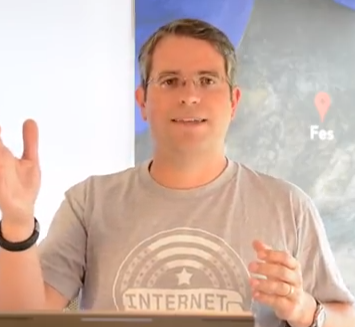
Matt Cutts is just toying with SEO’s these days.
Going by some comments, many SEOs still miss the big picture. Google is not in the business of enabling SEOs. So he may as well have a little fun – Matt has “called it” on guest posting.
Okay, I’m calling it: if you’re using guest blogging as a way to gain links in 2014, you should probably stop. Why? Because over time it’s become a more and more spammy practice, and if you’re doing a lot of guest blogging then you’re hanging out with really bad company.
The hen-house erupted.
The hens should know better by now. If a guest post is good for the audience and site, then do it. If it’s being done for no other reason than to boost rank in Google, then that’s a sign a publishing strategy is weak, high risk, and vulnerable to Google’s whims. Change the publishing strategy.
Measuring What Is Important
Although far from perfect, Google is geared towards recognizing utility. If Google doesn’t recognize utility, then Google will become weaker and someone else will take their place. Only a few people remember Alta Vista. They didn’t provide much in the way of utility, and Google ate their lunch.
Which brings me onto the importance of measurement.
It’s important we measure the right things. If people get upset because guest posting is called out, are they upset because they are counting the number of inbound links as if that were the only benefit? Why are they counting inbound links? To get a ranking boost? So, why are some people getting upset? They know Google doesn’t like marketing practices that serve no other purpose than to boost rank. Or are people concerned Google might confuse a post of genuine utility with link spam?
A publishing strategy based on nothing more than Google rankings is not a publishing strategy, it’s a tactic. Given the changes Google has made recently, it’s not a good tactic, because if they can isolate and eliminate SEO tactics, they will. Those who guest post on other sites, and offer guest post placement in order to provide utility, should continue to do so. They are unlikely to eliminate genuine utility, regardless of links, and at worst, they’ll likely ignore the site it appears on.
Interesting
To prosper, we need to be more interesting that the next guy. We need to focus on delivering “interestingness”.
The buzzword term is “visitor engagement”, but that really means “be interesting”. If we provide interesting material, people will read it, and if we provide it on a regular basis, they might come back, or remember our brand name, and then search on that brand name, and then they might link to it, and that this activity combined helps us rank. Ranking is a side effect of being genuinely interesting.
This is not to say measuring links, or page views, are unimportant. But they can be an oversimplification when taken in isolation.
Demand Media’s eHow focused on pageviews rather than engagement. Which is a big part of the reason why the guys who sold them eHow were able to beat them with wikiHow.
Success depends on achieving the underlying business goal. Perhaps high page views are not important if a site is targeting a very specific audience. Perhaps rankings aren’t all that important if most of the audience is on social media or repeat business. Sometimes, focusing on the wrong metrics leads to the wrong marketing tactics.
What else can we measure? Some common stuff….
- Page views
- Subscriptions
- Comments
- Quality of comments
- Syndication
- Time on site
- Videos watched
- Unique visitors
- Traffic sent to partner sites
- Bookmarking activity
- Search engine exposure
- Brand searches
- Offline mentions
- Online mentions
- Customer satisfaction
- Conversion rates
- Number of inquiries
- Relationships
- Sales
- Reduced costs
The choice of what we measure depends on what we’re trying to achieve. The SEO may say they are trying to achieve a high rank, but why? To get more traffic, perhaps. Why do we want more traffic? In the hope more people will buy our widget.
So, if buying more widgets is the goal, then perhaps more energy needs to be placed into converting the traffic we already have, as opposed to spending the same energy getting more? Perhaps more time needs to be spent on conversion optimization. Perhaps more time needs to be spent refining the offer. Or listening to customers. Hearing their objections. Writing Q&A that addresses those objections. Guest posting somewhere else and addressing industry wide objections. Thinking up products to sell to previous customers. Making them aware of changes via an email list. Optimizing the interest factor of your site to make it more interesting than your competitors, then treat the rankings as a bonus. Link building starts with “being interesting”.
When it comes to the guest post, if you’re only doing it to get a link, then you’re almost certainly selling yourself short. A guest post should serve a number of functions, such as building awareness, increasing reach, building brand, and be based on serving your underlying marketing objective. Pick where you post carefully. Deliver real value. If you do guest post, always try and extract way more benefit than just the link.
There was a time when people could put low-quality posts on low-quality sites and enjoy a benefit. But that practice is really just selling a serious web business short.
How Do We Know If We’re Interesting?
There are a couple of different types of measurement marketers use. One is an emotional response, where the visitor becomes “positively interested”. This is measured by recall studies, association techniques, customers surveys and questionnaires. However, the type of response on-line marketers focus on, which is somewhat easier to measure, is behavioural interest. When people are really interested, they do something in response.
So, to measure the effectiveness of a guest posting, we might look for increased name or brand searches. More linkedin views. We might look at how many people travel down the links. We look at what they do when they land on the site, and – the most important bit – whether they do whatever that thing is that translates to the bottom line. Was it subscribing? Commenting? Downloading a white paper? Watching a video? Getting in contact? Tweeting? Bookmarking? What was that thing you wanted them to do in order to serve your bottom line?
Measurement should be flexible and will be geared towards achieving business goals. SEOs may worry that if they don’t show rankings and links, then the customer will be dissatisfied. I’d wager the customer will be a lot more dissatisfied if they do get a lot of links and a rankings boost, yet no improvement in the bottom line. We could liken this to companies that have a lot of meetings. There is an air of busyness, but are they achieving anything worthwhile? Maybe. Maybe not. We should be careful not to mistake frenzy for productivity.
Measuring links, like measuring the number of meetings, is reductive. So is measuring engagement just by looking at clicks. The picture needs to be broad and strategic. So, if guest posts help you build your business, measured by business metrics, keep doing them. Don’t worry about what Google may or may not do, because it’s beyond your control, regardless.
Control what you can. Control the quality of information you provide.
Disavow & Link Removal: Understanding Google
Fear Sells
Few SEOs took notice when Matt Cutts mentioned on TWIG that “breaking their spirits” was essential to stopping spammers. But that single piece of information add layers of insights around things like:
- duplicity on user privacy on organic versus AdWords
- benefit of the doubt for big brands versus absolute apathy toward smaller entities
- the importance of identity versus total wipeouts of those who are clipped
- mixed messaging on how to use disavow & the general fear around links
From Growth to No Growth
Some people internalize failure when growth slows or stops. One can’t raise venture capital and keep selling the dream of the growth story unless the blame is internalized. If one understands that another dominant entity (monopoly) is intentionally subverting the market then a feel good belief in the story of unlimited growth flames out.
Most of the growth in the search channel is being absorbed by Google. In RKG’s Q4 report they mentioned that mobile ad clicks were up over 100% for the year & mobile organic clicks were only up 28%.
Investing in Fear
There’s a saying in investing that “genius is declining interest rates” but when the rates reverse the cost of that additional leverage surfaces. Risks from years ago that didn’t really matter suddenly do.
The same is true with SEO. A buddy of mine mentioned getting a bad link example from Google where the link was in place longer than Google has been in existence. Risk can arbitrarily be added after the fact to any SEO activity. Over time Google can keep shifting the norms of what is acceptable. So long as they are fighting off Wordpress hackers and other major issues they are kept busy, but when they catch up on that stuff they can then focus on efforts to shift white to gray and gray to black – forcing people to abandon techniques which offered a predictable positive ROI.
Defunding SEO is an essential & virtuous goal.
Hiding data (and then giving crumbs of it back to profile webmasters) is one way of doing it, but adding layers of risk is another. What panda did to content was add a latent risk to content where the cost of that risk in many cases vastly exceeded the cost of the content itself. What penguin did to links was the same thing: make the latent risk much larger than the upfront cost.
As Google dials up their weighting on domain authority many smaller sites which competed on legacy relevancy metrics like anchor text slide down the result set. When they fall down the result set, many of those site owners think they were penalized (even if their slide was primarily driven by a reweighting of factors rather than an actual penalty). Since there is such rampant fearmongering on links, they start there. Nearly every widely used form of link building has been promoted by Google engineers as being spam. 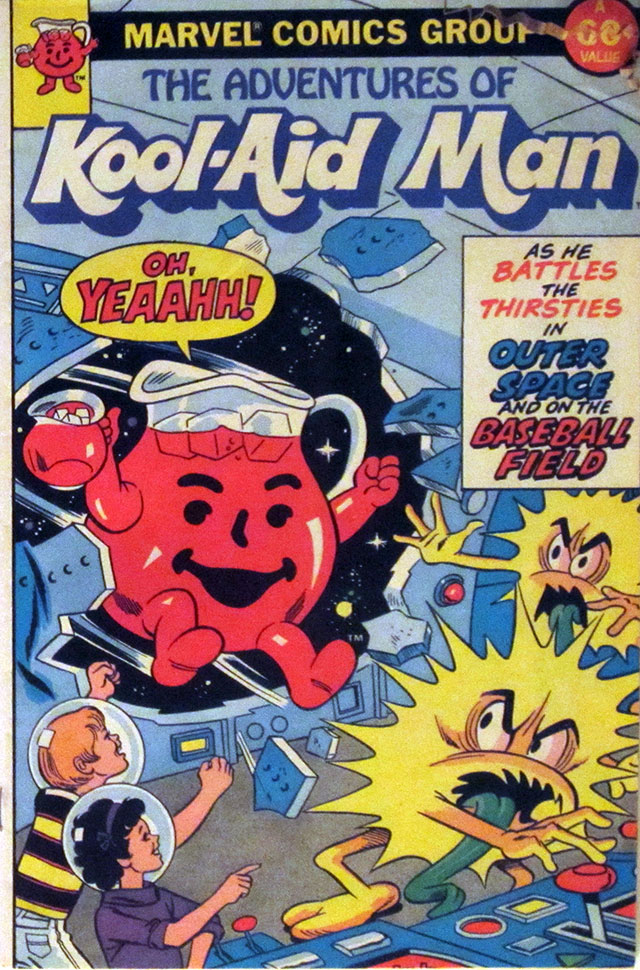
- Paid links? Spam.
- Reciprocal links? Spam.
- Blog comments? Spam.
- Forum profile links? Spam.
- Integrated newspaper ads? Spam.
- Article databases? Spam.
- Designed by credit links? Spam.
- Press releases? Spam.
- Web 2.0 profile & social links? Spam.
- Web directories? Spam.
- Widgets? Spam.
- Infographics? Spam.
- Guest posts? Spam.
It doesn’t make things any easier when Google sends out examples of spam links which are sites the webmaster has already disavowed or sites which Google explicitly recommended in their webmaster guidelines, like DMOZ.
It is quite the contradiction where Google suggests we should be aggressive marketers everywhere EXCEPT for SEO & basically any form of link building is far too risky.
It’s a strange world where when it comes to social media, Google is all promote promote promote. Or even in paid search, buy ads, buy ads, buy ads. But when it comes to organic listings, it’s just sit back and hope it works, and really don’t actively go out and build links, even those are so important. – Danny Sullivan
Google is in no way a passive observer of the web. Rather they actively seek to distribute fear and propaganda in order to take advantage of the experiment effect.
They can find and discredit the obvious, but most on their “spam list” done “well” are ones they can’t detect. So, it’s easier to have webmasters provide you a list (disavows), scare the ones that aren’t crap sites providing the links into submission and damn those building the links as “examples” – dragging them into town square for a public hanging to serve as a warning to anyone who dare disobey the dictatorship. – Sugarrae
This propaganda is so effective that email spammers promoting “SEO solutions” are now shifting their pitches from grow your business with SEO to recover your lost traffic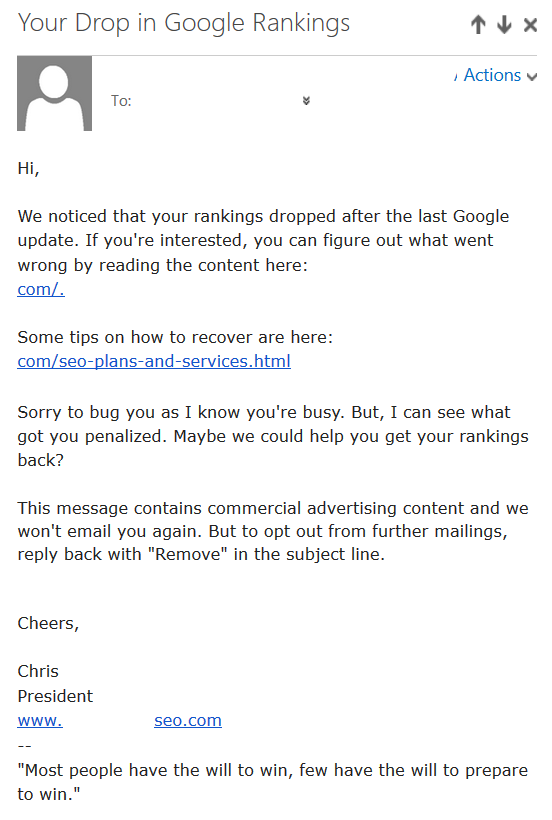
Where Do Profits Come From?
I saw Rand tweet this out a few days ago…
Google’s making manual link building less scalable, and that’s good. It means SEO is more valuable and less of a commodity.— Rand Fishkin (@randfish) January 22, 2014
… and thought “wow, that couldn’t possibly be any less correct.”
When ecosystems are stable you can create processes which are profitable & pay for themselves over the longer term.
I very frequently get the question: ‘what’s going to change in the next 10 years?’ And that is a very interesting question; it’s a very common one. I almost never get the question: ‘what’s not going to change in the next 10 years?’ And I submit to you that that second question is actually the more important of the two – because you can build a business strategy around the things that are stable in time….in our retail business, we know that customers want low prices and I know that’s going to be true 10 years from now. They want fast delivery, they want vast selection. It’s impossible to imagine a future 10 years from now where a customer comes up and says, ‘Jeff I love Amazon, I just wish the prices were a little higher [or] I love Amazon, I just wish you’d deliver a little more slowly.’ Impossible. And so the effort we put into those things, spinning those things up, we know the energy we put into it today will still be paying off dividends for our customers 10 years from now. When you have something that you know is true, even over the long-term, you can afford to put a lot of energy into it. – Jeff Bezos at re: Invent, November, 2012
When ecosystems are unstable, anything approaching boilerplate has an outsized risk added by the dominant market participant. The quicker your strategy can be done at scale or in the third world, the quicker Google shifts it from a positive to a negative ranking signal. It becomes much harder to train entry level employees on the basics when some of the starter work they did in years past now causes penalties. It becomes much harder to manage client relationships when their traffic spikes up and down, especially if Google sends out rounds of warnings they later semi-retract.
What’s more, anything that is vastly beyond boilerplate tends to require a deeper integration and a higher level of investment – making it take longer to pay back. But the budgets for such engagement dry up when the ecosystem itself is less stable. Imagine the sales pitch, “I realize we are off 35% this year, but if we increase the budget 500% we should be in a good spot a half-decade from now.”
All great consultants aim to do more than the bare minimum in order to give their clients a sustainable competitive advantage, but by removing things which are scalable and low risk Google basically prices out the bottom 90% to 95% of the market. Small businesses which hire an SEO are almost guaranteed to get screwed because Google has made delivering said services unprofitable, particularly on a risk-adjusted basis.
Being an entrepreneur is hard. Today Google & Amazon are giants, but it wasn’t always that way. Add enough risk and those streams of investment in innovation disappear. Tomorrow’s Amazon or Google of other markets may die a premature death. You can’t see what isn’t there until you look back from the future – just like the answering machine AT&T held back from public view for decades.
Meanwhile, the Google Venture backed companies keep on keeping on – they are protected.
Gotta love when G Ventures is lead investor in a company that is doing paid blog posts with anchor-friendly links.— valentine (@veezy) January 20, 2014
…and comment spam links, lol. classic.— valentine (@veezy) January 20, 2014
When ad agencies complain about the talent gap, what they are really complaining about is paying people what they are worth. But as the barrier to entry in search increases, independent players die, leaving more SEOs to chase fewer corporate jobs at lower wages. Even companies servicing fortune 500s are struggling.
On an individual basis, the ability to create value and the ability to be fairly compensated for the value you create is not the same thing. Look no further than companies like Google & Apple which engage in flagrantly illegal anti-employee cartel agreements. These companies “partnered” with their direct competitors to screw their own employees. Even if you are on a winning team it does not mean that you will be a winner after you back out higher living costs and such illegal employer agreements.
This is called now the winner-take-all society. In other words the rewards go overwhelmingly to just the thinnest crust of folks. The winner-take-all society creates incredibly perverse incentives to become a cheater-take-all society. Cause my chances of winning an honest competition are very poor. Why would I be the one guy or gal who would be the absolute best in the world? Why not cheat instead?” – William K Black
Meanwhile, complaints about the above sorts of inequality or other forms of asset stripping are pitched as being aligned with Nazi Germany’s treatment of Jews. Obviously we need more H-1B visas to further drive down wages even as graduates are underemployed with a mountain of debt.
A Disavow For Any (& Every) Problem
Removing links is perhaps the single biggest growth area in SEO.
Just this week I got an unsolicited email from an SEO listing directory
We feel you may qualify for a Top position among our soon to be launched Link Cleaning Services Category and we would like to learn more about Search Marketing Info. Due to the demand for link cleaning services we’re poised to launch the link cleaning category. I took a few minutes to review your profile and felt you may qualify. Do you have time to talk this Monday or Tuesday?
Most of the people I interact with tend to skew toward the more experienced end of the market. Some of the folks who join our site do so after their traffic falls off. In some cases the issues look intimately tied to Panda & the sites with hundreds of thousands of pages maybe only have a couple dozen inbound links. In spite of having few inbound links & us telling people the problem looks to be clearly aligned with Panda, some people presume that the issue is links & they still need to do a disavow file.
Why do they make that presumption? It’s the fear message Google has been selling nonstop for years.
Punishing people is much different, and dramatic, from not rewarding. And it feeds into the increasing fear that people might get punished for anything. – Danny Sullivan
 What happens when Google hands out free all-you-can-eat gummy bear laxatives to children at the public swimming pool? A tragedy of the commons.
What happens when Google hands out free all-you-can-eat gummy bear laxatives to children at the public swimming pool? A tragedy of the commons.
Rather than questioning or countering the fear stuff, the role of the SEO industry has largely been to act as lap dogs, syndicating & amplifying the fear.
- link tool vendors want to sell proprietary clean up data
- SEO consultants want to tell you that they are the best and if you work with someone else there is a high risk hidden in the low price
- marketers who crap on SEO to promote other relabeled terms want to sell you on the new term and paint the picture that SEO is a self-limiting label & a backward looking view of marketing
- paid search consultants want to enhance the perception that SEO is unreliable and not worthy of your attention or investment
Even entities with a 9 figure valuation (and thus plenty of resources to invest in a competent consultant) may be incorrectly attributing SEO performance problems to links.
A friend recently sent me a link removal request from Buy Domains referring to a post which linked to them.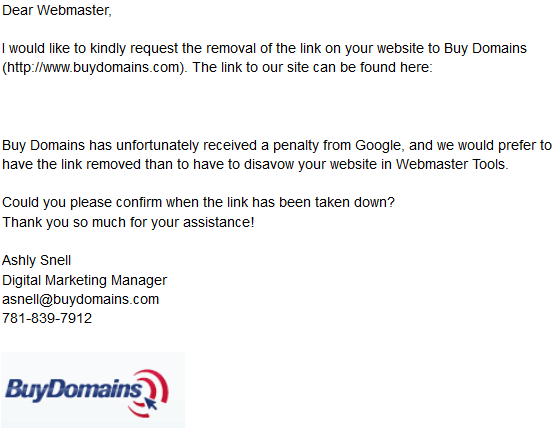
On the face of this, it’s pretty absurd, no? A company which does nothing but trade in names themselves asks that their name reference be removed from a fairly credible webpage recommending them.
The big problem for Buy Domains is not backlinks. They may have had an issue with some of the backlinks from PPC park pages in the past, but now those run through a redirect and are nofollowed.
Their big issue is that they have less than great engagement metrics (as do most marketplace sites other than eBay & Amazon which are not tied to physical stores). That typically won’t work if the entity has limited brand awareness coupled with having nearly 5 million pages in Google’s index.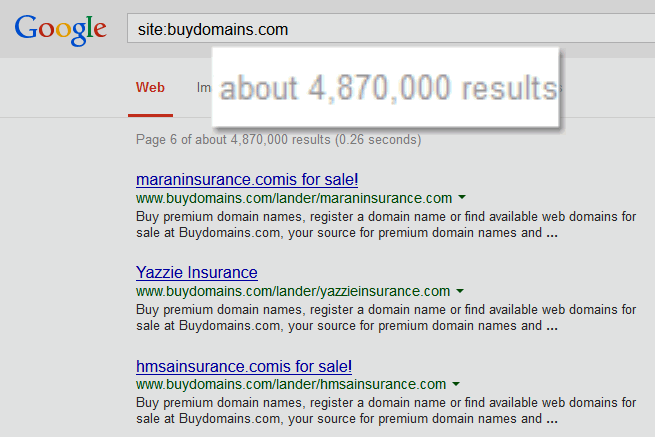
They not only have pages for each individual domain name, but they link to their internal search results from their blog posts & those search pages are indexed. Here’s part of a recent blog post
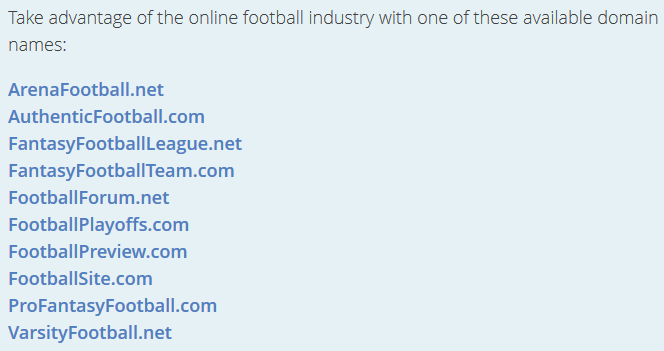
And here are examples of the thin listing sorts of pages which Panda was designed in part to whack. These pages were among the millions indexed in Google.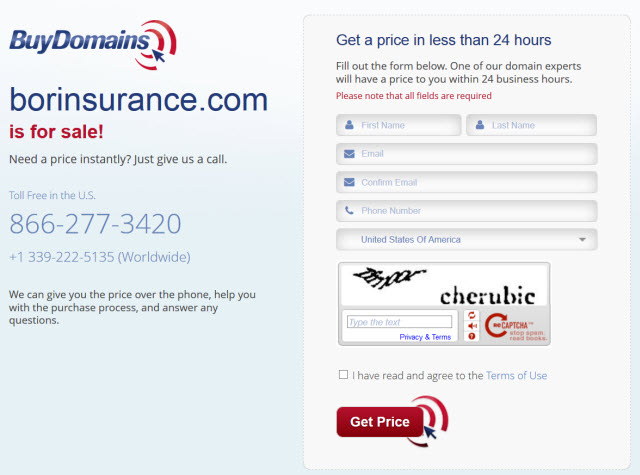

A marketplace with millions of pages that doesn’t have broad consumer awareness is likely to get nailed by Panda. And the websites linking to it are likely to end up in disavow files, not because they did anything wrong but because Google is excellent at nurturing fear.
What a Manual Penalty Looks Like
Expedia saw a 25% decline in search visibility due to an unnatural links penalty , causing their stock to fall 6.4%. Both Google & Expedia declined to comment. It appears that the eventual Expedia undoing stemmed from Hacker News feedback & coverage about an outing story on an SEO blog that certainly sounded like it stemmed from an extortion attempt. USA Today asked if the Expedia campaign was a negative SEO attack.
While Expedia’s stock drop was anything but trivial, they will likely recover within a week to a month.
Smaller players can wait and wait and wait and wait … and wait.
Manual penalties are no joke, especially if you are a small entity with no political influence. The impact of them can be absolutely devastating. Such penalties are widespread too.

In Google’s busting bad advertising practices post they highlighted having zero tolerance, banning more than 270,000 advertisers, removing more than 250,000 publishers accounts, and disapproving more than 3,000,000 applications to join their ad network. All that was in 2013 & Susan Wojcicki mentioned Google having 2,000,000 sites in their display ad network. That would mean that something like 12% of their business partners were churned last year alone.
If Google’s churn is that aggressive on their own partners (where Google has an economic incentive for the relationship) imagine how much broader the churn is among the broader web. In this video Matt Cutts mentioned that Google takes over 400,000 manual actions each month & they get about 5,000 reconsideration request messages each week, so over 95% of the sites which receive notification never reply. Many of those who do reply are wasting their time.
The Disavow Threat
Originally when disavow was launched it was pitched as something to be used with extreme caution:
This is an advanced feature and should only be used with caution. If used incorrectly, this feature can potentially harm your site’s performance in Google’s search results. We recommend that you disavow backlinks only if you believe you have a considerable number of spammy, artificial, or low-quality links pointing to your site, and if you are confident that the links are causing issues for you. In most cases, Google can assess which links to trust without additional guidance, so most normal or typical sites will not need to use this tool.
Recently Matt Cutts has encouraged broader usage. He has one video which discusses proatively disavowing bad links as they come in & another where he mentioned how a large company disavowed 100% of their backlinks that came in for a year.
The idea of proactively monitoring your backlink profile is quickly becoming mainstream – yet another recurring fixed cost center in SEO with no upside to the client (unless you can convince the client SEO is unstable and they should be afraid – which would ultimately retard their longterm investment in SEO).
Given the harshness of manual actions & algorithms like Penguin, they drive companies to desperation, acting irrationally based on fear.
People are investing to undo past investments. It’s sort of like riding a stock down 60%, locking in the losses by selling it, and then using the remaining 40% of the money to buy put options or short sell the very same stock. :D
Some companies are so desperate to get links removed that they “subscribe” sites that linked to them organically with spam email messages asking the links be removed.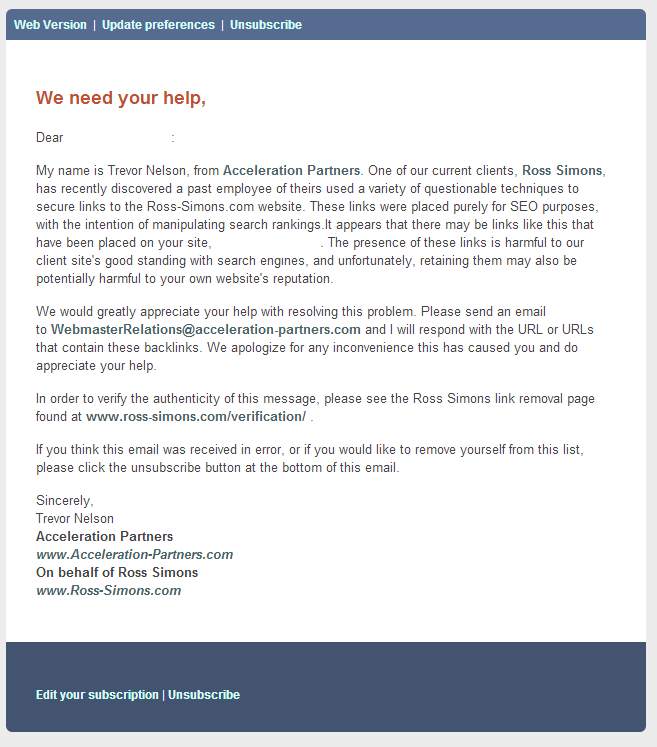
Some go so far that they not only email you on and on, but they created dedicated pages on their site claiming that the email was real.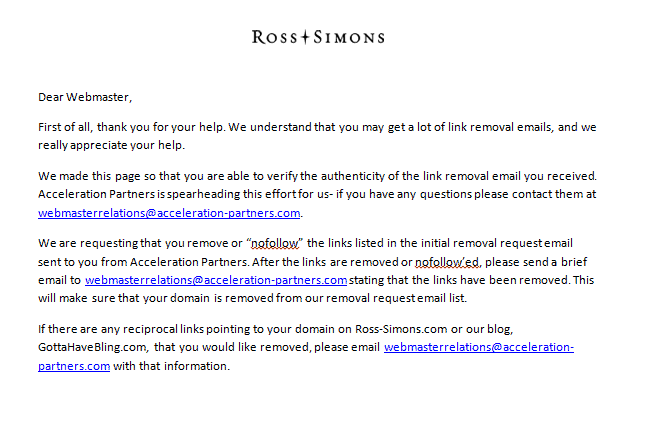
What’s so risky about the above is that many webmasters will remove links sight unseen, even from an anonymous Gmail account. Mix in the above sort of “this message is real” stuff and how easy would it be for a competitor to target all your quality backlinks with a “please remove my links” message? Further, how easy would it be for a competitor aware of such a campaign to drop a few hundred Dollars on Fiverr or Xrummer or other similar link sources, building up your spam links while removing your quality links?
A lot of the “remove my link” messages are based around lying to the people who are linking & telling them that the outbound link is harming them as well: “As these links are harmful to both yours and our business after penguin2.0 update, we would greatly appreciate it if you would delete these backlinks from your website.”
Here’s the problem though. Even if you spend your resources and remove the links, people will still likely add your site to their disavow file. I saw a YouTube video recording of an SEO conference where 4 well known SEO consultants mentioned that even if they remove the links “go ahead and disavow anyhow,” so there is absolutely no upside for publishers in removing links.
How Aggregate Disavow Data Could Be Used
Recovery is by no means guaranteed. In fact of the people who go to the trouble to remove many links & create a disavow file, only 15% of people claim to have seen any benefit.
The other 85% who weren’t sure of any benefit may not have only wasted their time, but they may have moved some of their other projects closer toward being penalized.

Let’s look at the process:
- For the disavow to work you also have to have some links removed.
- Some of the links that are removed may not have been the ones that hurt you in Google, thus removing them could further lower your rank.
- Some of the links you have removed may be the ones that hurt you in Google, while also being ones that helped you in Bing.
- The Bing & Yahoo! Search traffic hit comes immediately, whereas the Google recovery only comes later (if at all).
- Many forms of profits (from client services or running a network of sites) come systematization. If you view everything that is systematized or scalable as spam, then you are not only disavowing to try to recover your penalized site, but you are send co-citation disavow data to Google which could have them torch other sites connected to those same sources.
- If you run a network of sites & use the same sources across your network and/or cross link around your network, you may be torching your own network.
- If you primarily do client services & disavow the same links you previously built for past clients, what happens to the reputation of your firm when dozens or hundreds of past clients get penalized? What happens if a discussion forum thread on Google Groups or elsewhere starts up where your company gets named & then a tsunami of pile on stuff fills out in the thread? Might that be brand destroying?
The disavow and review process is not about recovery, but is about collecting data and distributing pain in a game of one-way transparency. Matt has warned that people shouldn’t lie to Google…
Don’t lie in a reconsideration request. Just don’t go there at all. Makes Matt *angry*! Matt smash spam!— Matt Cutts (@mattcutts) June 16, 2008
…however Google routinely offers useless non-information in their responses.
Some Google webmaster messages leave a bit to be desired.
Hey @mattcutts, have you seen the new Google manual action revoked messages? http://t.co/0NiYG0A3CB. Perhaps outsourcing too far ;-)…?— Dan Sharp (@screamingfrog) January 6, 2014
Recovery is uncommon. Your first response from Google might take a month or more. If you work for a week or two on clean up and then the response takes a month, the penalty has already lasted at least 6 weeks. And that first response might be something like this
Reconsideration request for site.com: Site violates Google’s quality guidelines
We received a reconsideration request from a site owner for site.com/.
We’ve reviewed your site and we believe that site.com/ still violates our quality guidelines. In order to preserve the quality of our search engine, pages from site.com/ may not appear or may not rank as highly in Google’s search results, or may otherwise be considered to be less trustworthy than sites which follow the quality guidelines.
For more specific information about the status of your site, visit the Manual Actions page in Webmaster Tools. From there, you may request reconsideration of your site again when you believe your site no longer violates the quality guidelines.
If you have additional questions about how to resolve this issue, please see our Webmaster Help Forum.
Absolutely useless.
Zero useful information whatsoever.
As people are unsuccessful in the recovery process they cut deeper and deeper. Some people have removed over 90% of their profile without recovering & been nearly a half-year into the (12-step) “recovery” process before even getting a single example of a bad link from Google. In some cases these bad links Google identified were links were obviously created by third party scraper sites & were not in Google’s original sample of links to look at (so even if you looked at every single link they showed you & cleaned up 100% of issues you would still be screwed.)
Another issue with aggregate disavow data is there is a lot of ignorance in the SEO industry in general, and people who try to do things cheap (essentially free) at scale have an outsized footprint in the aggregate data. For instance, our site’s profile links are nofollowed & our profiles are not indexed by Google. In spite of this, examples like the one below are associated with not 1 but 3 separate profiles for a single site.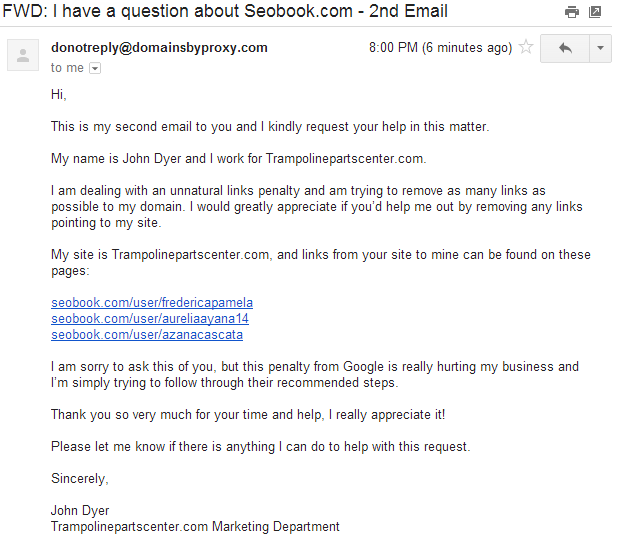
Our site only has about 20,000 to 25,000 unique linking domains. However over the years we have had well over a million registered user profiles. If only 2% of the registered user profiles were ignorant spammers who spammed our profile pages and then later added our site to a disavow file, we would have more people voting *against* our site than we have voting for it. And that wouldn’t be because we did anything wrong, but rather because Google is fostering an environment of mixed messaging, fear & widespread ignorance.
Another factor with Google saying “you haven’t cut out enough bone marrow yet” along with suggesting that virtually any/every type of link is spam is that there is going to be a lot of other forms of false positives in the aggregate data.
I know some companies specializing in link recovery which in part base some aspects of their disavows on the site’s ranking footprint. Well if you get a manual penalty, a Panda penalty, or your site gets hacked, then those sorts of sites which you are linking to may re-confirm that your site deserves to be penalized (on a nearly automated basis with little to no thought) based on the fact that it is already penalized. Good luck on recovering from that as Google folds in aggregate disavow data to justify further penalties.

Responsibility
All large ecosystems are gamed. We see it with app ratings & reviews, stealth video marketing, advertising, malware installs, and of course paid links.
Historically in search there has been the view that you are responsible for what you have done, but not the actions of others. The alternate roadmap would lead to this sort of insanity:
Our system has noticed that in the last week you received 240 spam emails. In result, your email account was temporarily suspended. Please contact the spammers and once you have a proof they unsuscribed you from their spam databases, we will reconsider reopening your email account.
As Google has closed down their own ecosystem, they allow their own $0 editorial to rank front & center even if it is pure spam, but third parties are now held to a higher standard – you could be held liable for the actions of others.
At the extreme, one of Google’s self-promotional automated email spam messages sent a guy to jail. In spite of such issues, Google remains unfazed, adding a setting which allows anyone on Google+ to email other members.
Ask Google if they should be held liable for the actions of third parties and they will tell you to go to hell. Their approach to copyright remains fuzzy, they keep hosting more third party content on their own sites, and even when that content has been deemed illegal they scream that it undermines their first amendment rights if they are made to proactively filter:
Finally, they claimed they were defending free speech. But it’s the courts which said the pictures were illegal and should not be shown, so the issue is the rule of law, not freedom of speech.
…
the non-technical management, particularly in the legal department, seems to be irrational to the point of becoming adolescent. It’s almost as if they refuse to do something entirely sensible, and which would save them and others time and trouble, for no better reason than that someone asked them to.
Monopolies with nearly unlimited resources shall be held liable for nothing.
Individuals with limited resources shall be liable for the behavior of third parties.
Google Duplicity (beta).
Torching a Competitor
As people have become more acclimated toward link penalties, a variety of tools have been created to help make sorting through the bad ones easier.
“There have been a few tools coming out on the market since the first Penguin – but I have to say that LinkRisk wins right now for me on ease of use and intuitive accuracy. They can cut the time it takes to analyse and root out your bad links from days to minutes…” – Dixon Jones
But as there have been more tools created for sorting out bad links & more tools created to automate sending link emails, two things have happened
- Google is demanding more links be removed to allow for recovery
Failed reconsideration requests are now coming with this email that tells site owners they must remove more links: pic.twitter.com/tiyXtPvY32— Marie Haynes (@Marie_Haynes) January 2, 2014
- people are becoming less responsive to link removal requests as they get bombarded with them
- Some of these tools keep bombarding people over and over again weekly until the link is removed or the emails go to the spam bin
- to many people the link removal emails are the new link request emails ;)
- one highly trusted publisher who participates in our forums stated they filtered the word “disavow” to automatically go to their trash bin
- on WebmasterWorld a member decided it was easier to delete their site than deal with the deluge of link removal spam emails
The problem with Google rewarding negative signals is there are false positives and it is far cheaper to kill a business than it is to build one. The technically savvy teenager who created the original version of the software used in the Target PoS attack sold the code for only $2,000.
There have been some idiotic articles like this one on The Awl suggesting that comment spamming is now dead as spammers run for the hills, but that couldn’t be further from the truth. Some (not particularly popular) blogs are getting hundreds to thousands of spam comments daily & Wordpress can have trouble even backing up the database (unless the comment spam is regularly deleted) as the database can quickly get a million records.
The spam continues but the targets change. A lot of these comments are now pointed at YouTube videos rather than ordinary websites.
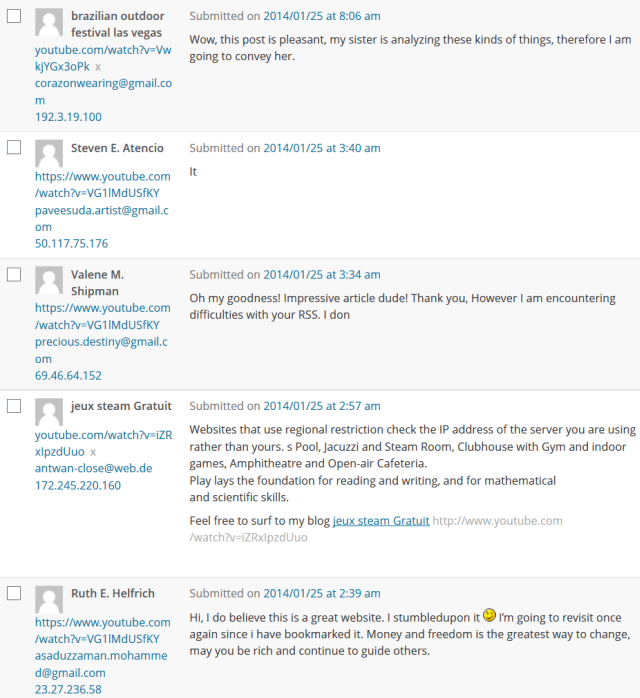
As Google keeps leaning into negative signals, one can expect a greater share of spam links to be created for negative SEO purposes.
Maybe this maternity jeans comment spam is tied to the site owner, but if they didn’t do it, how do they prove it?
With WMT admission that linkspam MUST be removed we are past tipping point; it’s now a risk to not engage in neg SEO against all comp. #sad— Cygnus SEO (@CygnusSEO) January 2, 2014
Once again, I’ll reiterate Bill Black
This is called now the winner-take-all society. In other words the rewards go overwhelmingly to just the thinnest crust of folks. The winner-take-all society creates incredibly perverse incentives to become a cheater-take-all society. Cause my chances of winning an honest competition are very poor. Why would I be the one guy or gal who would be the absolute best in the world? Why not cheat instead?” – William K Black
The cost of “an academic test” can be as low as $5. You know you might be in trouble when you see fiverr.com/conversations/theirusername in your referrers:
Our site was hit with negative SEO. We have manually collected about 24,000 bad links for our disavow file (so far). It probably cost the perp $5 on Fiverr to point these links at our site. Do you want to know how bad that sucks? I’ll tell you. A LOT!! Google should be sued enmass by web masters for wasting our time with this “bad link” nonsense. For a company with so many Ph.D’s on staff, I can’t believe how utterly stupid they are
Or, worse yet, you might see SAPE in your referrers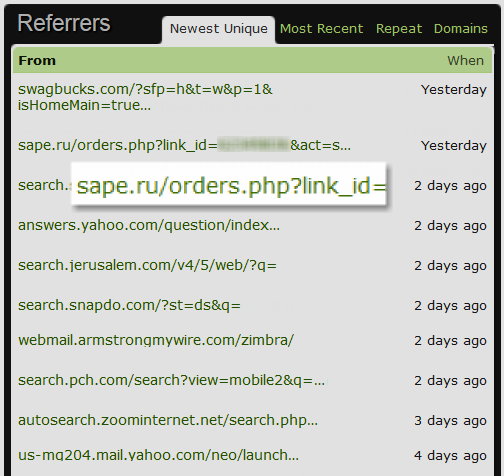
And if the attempt to get you torched fails, they can try & try again. The cost of failure is essentially zero. They can keep pouring on the fuel until the fire erupts.
 Even Matt Cutts complains about website hacking, but that doesn’t mean you are free of risk if someone else links to your site from hacked blogs. I’ve been forwarded unnatural link messages from Google which came about after person’s site was added in on a SAPE hack by a third party in an attempt to conceal who the beneficial target was. When in doubt, Google may choose to blame all parties in a scorched Earth strategy.
Even Matt Cutts complains about website hacking, but that doesn’t mean you are free of risk if someone else links to your site from hacked blogs. I’ve been forwarded unnatural link messages from Google which came about after person’s site was added in on a SAPE hack by a third party in an attempt to conceal who the beneficial target was. When in doubt, Google may choose to blame all parties in a scorched Earth strategy.
If you get one of those manual penalties, you’re screwed.
Even if you are not responsible for such links, and even if you respond on the same day, and even if Google believes you, you are still likely penalized AT LEAST for a month. Most likely Google will presume you are a liar and you have at least a second month in the penalty box. To recover you might have to waste days (weeks?) of your life & remove some of your organic links to show that you have went through sufficient pain to appease the abusive market monopoly.
As bad as the above is, it is just the tip of the iceberg.
- People can redirect torched websites.
- People can link to you from spam link networks which rotate links across sites, so you can’t possibly remove or even disavow all the link sources.
- People can order you a subscription of those rotating spam links from hacked sites, where new spam links appear daily. Google mentioned discovering 9,500 malicious sites daily & surely the number has only increased from there.
- People can tie any/all of the above with cloaking links or rel=canonical messages to GoogleBot & then potentially chain that through further redirects cloaked to GoogleBot.
- And on and on … the possibilities are endless.
Extortion
 Another thing this link removal fiasco subsidizes is various layers of extortion.
Another thing this link removal fiasco subsidizes is various layers of extortion.
Not only are there the harassing emails threatening to add sites to disavow lists if they don’t remove the links, but some companies quickly escalate things from there. I’ve seen hosting abuse, lawyer threat letters, and one friend was actually sued in court (and the people who sued him actually had the link placed!)
Google created a URL removal tool which allows webmasters to remove pages from third party websites. How long until that is coupled with DDoS attacks? Once effective with removing one page, a competitor might decide to remove another.
Another approach to get links removed is to offer payment. But payment itself might encourage the creation of further spammy links as link networks look to replace their old cashflow with new sources.
The recent Expedia fiasco started as an extortion attempt: “If I wanted him to not publish it, he would “sell the post to the highest bidder.”
Another nasty issue here is articles like this one on Link Research Tools, where they not only highlight client lists of particular firms, but then state which URLs have not yet been penalized followed by “most likely not yet visible.” So long as that sort of “publishing” is acceptable in the SEO industry, you can bet that some people will hire the SEOs nearly guaranteeing a penalty to work on their competitor’s sites, while having an employee write a “case study” for Link Research Tools. Is this the sort of bullshit we really want to promote?
Some folks are now engaging in overt extortion:
I had a client phone me today and say he had a call from a guy with an Indian accent who told him that he will destroy his website rankings if he doesn’t pay him £10 per month to NOT do this.
Branding / Rebranding / Starting Over
Sites that are overly literal in branding likely have no chance at redemption. That triple hyphenated domain name in a market that is seen as spammy has zero chance of recovery.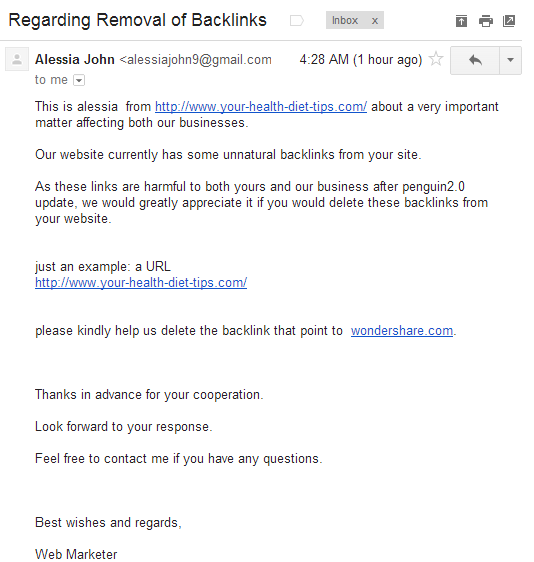
Even being a generic unbranded site in a YMYL category can make you be seen as spam. The remote rater documents stated that the following site was spam…
… even though the spammiest thing on it was the stuff advertised in the AdSense ads:
For many (most?) people who receive a manual link penalty or are hit by Penguin it is going to be cheaper to start over than to clean up.
At the very minimum it can make sense to lay groundwork for a new project immediately just in case the old site can’t recover or takes nearly a year to recover. However, even if you figure out the technical bits, as soon as you have any level of success (or as soon as you connect your projects together in any way) you once again become a target.
And you can’t really invest in higher level branding functions unless you think the site is going to be around for many years to earn off the sunk cost.
Succeeding at SEO is not only about building rank while managing cashflow and staying unpenalized, but it is also about participating in markets where you are not marginalized due to Google inserting their own vertical search properties.
Even companies which are large and well funded may not succeed with a rebrand if Google comes after their vertical from the top down.
Hope & Despair
If you are a large partner affiliated with Google, hope is on your side & you can monetize the link graph: “By ensuring that our clients are pointing their links to maximize their revenue, we’re not only helping them earn more money, but we’re also stimulating the link economy.”
You have every reason to be Excited, as old projects like Excite or Merchant Circle can be relaunched again and again.
Even smaller players with the right employer or investor connections are exempt from these arbitrary risks.
@badams @seobook They claim to have removed just over 200 links! Here we have people removing hundreds of thousands and still going nowhere!— Rohan Ayyar (@searchrook) January 6, 2014
You can even be an SEO and start a vertical directory knowing you will do well if you can get that Google Ventures investment, even as other similar vertical directories were torched by Panda.
Hehhe just saw a guest post complete with commercial anchor written by an “SEO Guru” whose also a Google employee— Tony Spencer (@notsleepy) January 7, 2014
For most other players in that same ecosystem, the above tailwind is a headwind. Don’t expect much 1 on 1 help in webmaster tools.
In this video Matt Cutts mentioned that Google takes over 400,000 manual actions each month & they get about 5,000 reconsideration request messages each week, so over 95% of the sites which receive notification never reply. Many of those who reply are wasting their time. How many confirmed Penguin 1.0 recoveries are you aware of?
Even if a recovery is deserved, it does not mean one will happen, as errors do happen. And on the off chance recovery happens, recovery does not mean a full restoration of rankings.
There are many things we can learn from Google’s messages, but probably the most important is this:
It was the best of times, it was the worst of times, it was the age of wisdom, it was the age of foolishness, it was the epoch of belief, it was the epoch of incredulity, it was the season of Light, it was the season of Darkness, it was the spring of hope, it was the winter of despair, we had everything before us, we had nothing before us, we were all going direct to heaven, we were all going direct the other way – in short, the period was so far like the present period, that some of its noisiest authorities insisted on its being received, for good or for evil, in the superlative degree of comparison only. – Charles Dickens, A Tale of Two Cities
Yahoo! Secured Search Rolls Out
Yahoo! is currently rolling out secured search, which prevents sending referrers to unsecured sites. The roll out is ongoing, but currently they do pass data to secured sites. Unlike Google’s secured search roll out:
rather than showing a referrer wit…
Google’s Chris DiBona On Search Ecosystem Diversity
It’s hard to deny that some folks working at Google are geniuses. It’s also hard to deny the disconnect in their messaging.
As Google locked down their “open” ecosystem (compatibility as a club, abandonware, deleting privacy settings, extensions required to be installed from store, extensions required to be single-purpose, forced Google+ integration, knowledge graph scrape-n-displace, “We could either sue him or hire him,” etc.), I thought an interview of one of their open source evangelists would be entertaining.
Chris DiBona delivered:
Can you imagine if you didn’t have the malware protection and the process isolation of Chrome, that Chrome brought to other browsers? Can you imagine surfing the web the way it is right now? It’s pretty grim. There’s a lot of malware. You end up basically funnelling people into fewer and fewer sites, and therefore fewer and fewer viewpoints and all the rest.
Sometimes large sites serve malware through their ads. Ad networks are one of the best ways to distribute malware. The super networks core to the web ecosystem are home to much of the malware – even GoogleBot was tricked into doing MySQL injection attacks. But even if we ignored that bit, it doesn’t take much insight to realize that Google is achieving that same kill diversity “goal” through other means…
This Mozcast chart always looks the same. As the web grows, Google allows less and less of it to appear in search. http://t.co/PRX4NGHZfH— Dan Thies (@danthies) September 4, 2013
…as they roll out many algorithmic filters, manual penalties, selectively enforce these issues on smaller players (while giving more exploitative entities a free pass), insert their own vertical search services, dial up their weighting on domain authority, and require smaller players to proactively police the rest of the web while Google thinks the n-word 85 times is totally reasonable on their own tier-1 properties.
We have another post coming on the craziness of disavows and link removals, but it has no doubt gone beyond absurd at this point.
Failed reconsideration requests are now coming with this email that tells site owners they must remove more links: pic.twitter.com/tiyXtPvY32— Marie Haynes (@Marie_Haynes) January 2, 2014
With WMT admission that linkspam MUST be removed we are past tipping point; it’s now a risk to not engage in neg SEO against all comp. #sad— Cygnus SEO (@CygnusSEO) January 2, 2014
Why is diversity so important?
Dissent evolves markets. The status quo doesn’t get changed by agreeing & aligning with existing power structures. Anyone who cares to debate this need only look at Google’s ongoing endless string of lawsuits. Most of those lawsuits are associated with Google (rightly or wrongly) taking power from what they view as legacy entities.
Even on a more personal level, one’s investment returns are likely to be better when things are out of favor:
“Investors should remember that excitement and expenses are their enemies. And if they insist on trying to time their participation in equities, they should try to be fearful when others are greedy and greedy only when others are fearful.” – Warren Buffett
In many markets returns and popularity are inversely proportional
Investing in Internet stocks in 1999 was popular, but for those who stayed too long at the party it was a train wreck. Domain name speculators who bought into the carnage a couple years later did well.
Society is so complex & inter-connected that its very easy to think things run far more smoothly than they do & thus buy into to many fibs that are obviously self-evident until the moment they are not.
Popularity is backward looking, enabling the sheep to be sheared.
Unfortunately depth & diversity are being sacrificed to promote pablum from well known entities in formats that are easy to disintermediate & monetize.
Think about it: an actual scientist who produces actual knowledge should be more like a journalist who recycles fake insights! This is beyond popularisation. This is taking something with value and substance and coring it out so that it can be swallowed without chewing. This is not the solution to our most frightening problems – rather this is one of our most frightening problems.
– Benjamin Bratton
Innovative knowledge creation and thought reading tattoos — the singularity is near.
